Geochemical Characteristics, Palaeoenvironment and Provenance of Uranium-Bearing Sandstone in the Sifangtai Formation, Northern Songliao Basin, Northeast China
Abstract
:1. Introduction
2. Geological Setting and Sample Descriptions
3. Analytical Methods
4. Analytical Results
4.1. Major Elements
4.2. Trace and Rare Earth Elements
5. Discussion
5.1. Sedimentary Sorting and Recycling
5.2. Weathering Degree
5.3. Depositional Environment
5.3.1. Paleosalinity Determination
5.3.2. Palaeoredox Conditions
5.3.3. Paleoclimate Conditions
5.4. Provenance Conditions
5.5. Tectonic Background
5.6. Relationship between the Sandstones and Uranium Mineralization
5.6.1. Uranium Source Conditions
5.6.2. Tectonic Conditions and Uranium Mineralization
5.6.3. Sand Body Development Conditions
5.6.4. Oxidation Zone Development Conditions
5.6.5. Paleoclimatic Conditions
5.6.6. Uranium Mineralization Development
6. Conclusions
- The ICV value ranged from 0.60 to 1.03, with an average of 0.69. The revised average CIA value was 54.35. It indicated that the rocks of the Sifangtai Formation might have undergone weak chemical weathering and the compositional homogeneity and minimal influence of sedimentary sorting.
- The combination of element Sr/Ba, 100MgO/Al2O3 and the combination of v/v + Ni, V/Cr, Ni/Co, Sr/Cu indicated that the paleo-water medium was deposited in an oxygen-rich freshwater environment when the Sifangtai Formation was deposited.
- On the structure discriminate diagrams, it showed that almost all the sandstones of the Sifangtai Formation fell in the range of active continental margin, indicating that the source area of the sandstones of Sifangtai Formations is an active continental margin tectonic environment, and the source is a felsic rock developed in the Xiaoxing’an Ridge and Zhangguangcailing area.
- Diagrams of major (trace) elements reveal the paleoclimate of the source area and the warm arid climate prevails during the deposition period.
- Based on the above comprehensive analyses, it was concluded that the paleo-climate, oxygen-rich paleo-water body, favorable sedimentary facies and thick sand bodies had important geological significance for the large-scaled mineralization of the sandstone-type uranium in the northern margin of the Songliao basin.
Author Contributions
Funding
Institutional Review Board Statement
Informed Consent Statement
Data Availability Statement
Conflicts of Interest
References
- Chen, Z.Y.; Chen, D.S.; Gu, K.H.; Wang, Y.J. The regional distribution of ore-bearing horizon, mineralization type and mineralization age of sandstone-type uranium deposits in China. Uranium Geol. 2010, 26, 321–330, (In Chinese with English abstract). [Google Scholar]
- Nie, F.J.; Li, M.G.; Yan, Z.B.; Xia, F.; Zhang, C.Y.; Yang, J.X.; Kang, S.H.; Shen, K.F. Sublevel and Uranium Mineralization of Saihan Formation Target Layer of Sandstand-type Uranium Deposit in Erlian Basin, Inner Mongolia. Geol. Bull. China 2015, 34, 1952–1963, (In Chinese with English abstract). [Google Scholar]
- Tang, C.; Wei, J.L.; Xiao, P.; Xu, Z.L.; Zeng, H.; Xu, L.L.; Guo, H.; Zhao, L.J. Study on occurrence state of uranium in sandstone-type uranium deposit in northern Songliao basin. Miner. Resour. Geol. 2017, 32, 1010–1016, (In Chinese with English abstract). [Google Scholar]
- Zhang, J.D. Potential and evaluation of uranium resources in China. Chin. Unclear Ind. 2008, 2, 18–21, (In Chinese with English abstract). [Google Scholar]
- Zhang, X.; Nie, F.J. Analysis of provenance of the uranium-bearing target layer and its tectonic setting in the Shihongtan uranium deposit Xinjiang:evidence from the petrology and geochemistry. Sci. Technol. Eng. 2019, 19, 86–92, (In Chinese with English abstract). [Google Scholar]
- Xia, F.Y.; Jiao, Y.Q.; Rong, H.; Zhu, Q.; Wan, L.L. Geochemical Characteristics and Geological Implications of Sandstones from the Yaojia Formation in Qianjiadian Uranium Deposit, Southern Songliao Basin. Earth Sci. 2019, 44, 4236–4251, (In Chinese with English abstract). [Google Scholar]
- Xu, Z.L.; Li, H.L.; Li, J.G.; Zhu, H.; Cao, M.Q.; Wei, J.L. Geochemistry of the Yaojia Formation Sandstone in the Kailu Depression, Songliao Basin: Implications for its Provenance and Tectonic Setting. Bull. Mineral. Petrol. Geochem. 2019, 38, 572–586, (In Chinese with English abstract). [Google Scholar]
- Lu, C.; Peng, Y.B.; Liu, X.Y.; Jiao, Y.Q.; Yang, J.X.; Chen, F.Z.; Shen, K.F.; Li, R.L. Sedimentary background of sndstone-type uranium deposits in western manite dpression of Erlian basin. Uranium Geol. 2013, 29, 336–343, (In Chinese with English abstract). [Google Scholar]
- Wu, B.L.; Zhang, W.Y.; Song, Z.S.; Cun, X.N.; Sun, L.; Luo, J.J.; Li, Y.Q.; Cheng, X.H.; Sun, B. Geological and geochemical characteristics of uranium minerals in the sandstone-type uranium depos in the north of Ordos basin and their gentic significance. Acta Geol. Sin. 2016, 90, 3393–3407, (In Chinese with English abstract). [Google Scholar]
- Zhang, T.F.; Sun, L.X.; Zhang, Y.; Cheng, Y.H.; Li, Y.F.; Ma, H.L.; Lu, C. The geochemical characteristics of trace and rare earth elements in the mudstone of Yanan Formation and Zhuluo Formation in the northern margin of ordos basin and their paleo~sedimentary environment significance. Acta Geol. Sin. 2016, 90, 3454–3472, (In Chinese with English abstract). [Google Scholar]
- Yang, D.G.; Wu, J.H.; Nie, F.J.; Bonnetti, C.; Xia, F.; Yan, Z.B.; Cai, J.F.; Wang, C.d.; Wang, H.T. Petrogenetic Constraints of Early Cenozoic Mafic Rocks in the Southwest Songliao Basin, NE China: Implications for the Genesis of Sandstone-Hosted Qianjiadian Uranium Deposits. Minerals 2020, 10, 1014. [Google Scholar] [CrossRef]
- Zhang, M.Y.; Zheng, J.W.; Tian, S.F.; Liu, H.B. Researchon Existing State of Uranium and Uranium Ore-Formation Age at Qianjiadian Uranium Deposit inKailu Depression. Uranium Geol. 2005, 21, 213–218, (In Chinese with English abstract). [Google Scholar]
- Rong, H.; Jiao, Y.Q.; Wu, L.Q.; Ji, D.M.; Li, H.L.; Zhu, Q. Epigenetic alteration of qianjiadian uranium deposit in the south of songliao basin and its constraint on uranium mineralization. Earth Sci. 2016, 41, 153–166, (In Chinese with English abstract). [Google Scholar]
- Chen, F.H.; Zhang, M.Y.; Lin, C.S. The sedimentary environment of the yaojia Formation and its uranium-rich significance in the Qianjiadian sag, Kailu basin. Sediment. Tethys Geol. 2005, 25, 74–79, (In Chinese with English abstract). [Google Scholar]
- Chen, X.L.; Fang, X.X.; Guo, Q.Y.; Pang, Y.Q.; Sun, Y. A new understanding of uranium mineralization in Qianjiadian sag, Songliao basin. Acta Geol. Sin. 2008, 82, 553–561, (In Chinese with English abstract). [Google Scholar]
- Xiao, P.; Tang, C.; Wei, J.L.; Xu, Z.L.; Zeng, H.; Liu, H.J. Sedimentary facies of the Sifangtai Formation in the southern Daqing placanticline and its controls to uranium mineralization. Geol. Surv. Res. 2018, 41, 18–24, (In Chinese with English abstract). [Google Scholar]
- Ma, H.F.; Luo, Y.; Li, Z.Y.; He, Z.B.; Wang, M.T. Sedimentary Features and Uranium Metallogenic Conditions of Yaojia Formation in Southern Songliao Basin. Uranium Geol. 2008, 25, 144–149, (In Chinese with English abstract). [Google Scholar]
- Liu, X.Y. Prospecting Direction of Sandstone Type Uranium Deposits in Erlian Basin. Uranium Geol. 2021, 01, 51–60, (In Chinese with English abstract). [Google Scholar]
- Li, J.; Gui, H.R.; Chen, L.W.; Fang, P.; Li, G.P.; Li, R.R. Geochemical characteristics, palaeoenvironment, and provenance of marine mudstone in Shanxi Formation of Huaibei Coalfield, southern North China Plate. Geol. J. 2021, 56, 3064–3080. [Google Scholar] [CrossRef]
- Nebitt, H.W. Movility and fraction of rare earth elements during weathering of a granodiorete. Nature 1979, 279, 206–210. [Google Scholar] [CrossRef]
- McLennan, S.M.; Taylor, S.R. Sedimentary rocks and crustal evolution revisted: Tectonnic setting and secular trends. Geology 1991, 99, 1–21. [Google Scholar] [CrossRef]
- McLennan, S.M.; Hemming, S.R.; McDaniel, D.K. Geochemical apporaches to sedmientation provenance and tectonics. In Processes Controlling the Composition of Clastic Sediments; Johnsson, M.J., Basu, A., Eds.; Geological Society of America, Inc.: Boulder, CO, USA, 1993; Volume 284, pp. 21–40. [Google Scholar]
- Algeo, T.J.; Maynard, J.B. Trace element behavior and redox facies in core shales of upper Pennsy lvanian Kansas type cyclotheme. Chem. Geol. 2004, 206, 289–318. [Google Scholar] [CrossRef]
- Algeo, T.J.; Tribovillard, N. Environmental analysis of paleoceanographic systems based in on molybedenum uranium covariation. Chem. Geol. 2009, 268, 211–225. [Google Scholar] [CrossRef]
- Calvert, S.E.; Pederesen, T.D. Geochemistry of recent oxic and anoxic marine sedments:implications for the geological record. Mar. Geol. 1993, 113, 67–88. [Google Scholar] [CrossRef]
- Li, S.C.; Zhang, J.Y.; Gong, F.H.; Zhu, H.; Bai, Y.F. The characteristics of mudstones of Upper Cretaceous Qingshankou Formation and favorable area optimization of shale oil in the north of Songliao Basin. Geol. Bull. China 2017, 36, 654–663, (In Chinese with English abstract). [Google Scholar]
- Liu, X.H.; Luo, M. Analysis on uranium metallogenic conditions and prospecting direction of Sifangtai Formation in TaiKang of Songliao Basin. Geol. Resour. 2021, 30, 14–20, (In Chinese with English abstract). [Google Scholar]
- Dai, W.Y.; Li, Y.; Zhao, Z.H.; Zhang, Y.; Zhang, H. Exploration on metallogenic conditions and prospecting direction of Jurassic sandstone type uranium deposit in Northeast margin of songliao basin. Geol. Resour. 2019, 28, 519–526, (In Chinese with English abstract). [Google Scholar]
- Zhou, J.B.; Zhang, X.Z.; Ma, Z.H. Tectonic framework and basin evolution in Northeast China. Oil Gas Geol. 2009, 30, 530–538. [Google Scholar]
- Liu, J.L.; Qin, M.K.; Cai, Y.Q.; Liu, Z.Y.; Zhang, Z.M.; Yao, L. Late Mesozoic tectonic evolution of the southern Great Xing’an Range, northeastern China: Constraints from detrital zircon U–Pb and Hf isotopes of Late Cretaceous sandstones.in the southwestern Songliao Basin. Geol. J. 2020, 55, 4415–4425. [Google Scholar] [CrossRef]
- Feng, Z.Q.; Zhang, S.; Fu, X.L. Sedimentary evolution and accumulation response of yaojia Formation and nenjiang Formation in songliao basin. Earth Sci. Front. 2012, 19, 78–87, (In Chinese with English abstract). [Google Scholar]
- Jiao, Y.Q.; Wu, L.Q.; Peng, Y.B. Sedimentary~tectonic settting of the deposition type uranium deposits forming in the Paleo—Asian tetonic domain, North China. Earth Sci. Front. 2015, 22, 189–205. [Google Scholar]
- Li, J.; Huang, Z.L.; Li, L.J.; Liu, B.Z. A new understanding of uplift process in the southeastern uplift area of songliao basin. Xinjiang Pet. Geol. 2008, 29, 690–692, (In Chinese with English abstract). [Google Scholar]
- Shi, S.S.; Ren, J.Y.; Zhang, S.; Fu, X.L.; Tang, S.M. Sequence Stratigraphic Framework and its foemation mechanism of Post~Rift inversion successin in North of Songliao Basin, China. Earth Sci.-J. Univ. Geosci. 2012, 37, 545–555, (In Chinese with English abstract). [Google Scholar]
- Sun, Y.H.; Bai, L.; Fu, X. Genetic mechanism of T2 reflector fault density belt in northern Songliao basin. Earth Sci. 2013, 38, 797–805, (In Chinese with English abstract). [Google Scholar]
- Song, Y.; Ren, J.Y.; Yang, H.Z.; Tong, J.J.; Lei, C. Characteristics and dynamic background of bottom boundary in Yaojia Formation of the northern Songliao Basin. Acta Petrol. Sin. 2010, 31, 187–195, (In Chinese with English abstract). [Google Scholar]
- Chen, F.K.; Siebel, W.; Satir, M. Geochronology of the Karadere basement (N W T urkey) and implications for the geological evolution of the Istanbul zone. Int. J. Earth Sci. 2002, 91, 469–481. [Google Scholar] [CrossRef]
- Herron, M.M. Geochemical classification of terrigenous sands and shales from core or log data. J. Sediment. Petrol. 1998, 58, 820–829. [Google Scholar] [CrossRef]
- Sun, S.S.; McDonough, W.F. Chemical and isotopic systematics of oceanic basalts: Implications for mantle composition and processes. In Magmatism in Ocean Basins; Saunders, A.D., Norry, M.J., Eds.; Geological Society of Special Publication: London, UK, 1989; Volume 27, pp. 313–345. [Google Scholar]
- Cox, R.; Lowe, D.R.; Cullers, R.L. The infuence of sediment recyling and basement composition on evolution of mudrock chemistry in the south western United States. Geochim. Cosmochim. Acta 1995, 59, 2919–2940. [Google Scholar] [CrossRef]
- Cullers, R.L.; Podkovyrov, V.N. Geochemistry of the Mesoproterozoic Lakhanda shales in southeastern Yakutia, Russia: Implications for mineralogical and provenance control, and recycling. Precambrian Res. 2000, 104, 77–93. [Google Scholar] [CrossRef]
- Fathy, D.; Wagreich, M.; Zaki, R.; Mohamed, R.S.A.; Gier, S. Geochemical fingerprinting of Maastrichtian oil shales from the Central Eastern Desert, Egypt: Implications for provenance, tectonic setting, and source area weathering. Geol. J. 2018, 53, 2597–2612. [Google Scholar] [CrossRef]
- Nesbitt, H.W.; Young, G.M. Early Proterozoic climates and plate motions inferred from major element chemistry of lutites. Nature 1982, 299, 715–717. [Google Scholar] [CrossRef]
- Nesbitt, H.W.; Young, G.M. Prediction of some weathering trends of plutonic and volcanic rocks based on thermodynamic and kinetic considerations. Geochim. Cosmochim. Acta 1984, 48, 1523–1534. [Google Scholar] [CrossRef]
- Fedo, C.M.; Nesbitt, H.W.; Young, G.M. Unraveling the effects of potassium metasomatism in sedimentary rocks and paleosols, with implications for paleoweathering conditions and povenance. Geology 1995, 23, 921–924. [Google Scholar] [CrossRef]
- Kasanzu, C.; Maboko, M.A.H.; Manya, S. Geochemistry of finegrained clastic sedimentary rocks of the Neoproterozoic Ikorongo Group, NE Tanzania: Implications for provenance and source rock weathering. Precambrian Res. 2008, 164, 201–213. [Google Scholar] [CrossRef]
- Deng, H.W.; Qian, K. Sedimentary Geochemistary and Environmental Analysis; Gansu Science and Technology Press: Lanzhou, China, 1994; pp. 1–154. [Google Scholar]
- Jones, B.; Manning, D.A.C. Comparion of geochemical indices used for the interpretation of palaeoredox conditions in ancient mudstones. Chem. Geol. 1994, 111, 111–129. [Google Scholar] [CrossRef]
- Lermanm, A. Lakes: Chemistry, Geology, Physics; Lerman, A., Ed.; Springer: Berlin, Germany, 1978; pp. 79–83. [Google Scholar]
- Tribovillard, N.; Algeo, T.J.; Lyons, T. Trace metals as paleoredox and paleoproductivity proxies: Anudate. Chem. Geol. 2006, 232, 12–32. [Google Scholar] [CrossRef]
- Schieber, J.A. Combined petrographical-geochemical provenance study of the Newland Formation, Mid-Proterozoic of Montana. Geol. Mag. 1992, 129, 223–237. [Google Scholar] [CrossRef] [Green Version]
- Hayashi, K.I.; Fujisawa, H.; Holland, H.D. Geochemistry of ~1.9Ga sedimentary rocks from northeastern Labrador, Canada. Geochim. Cosmochim. Acta 1997, 61, 4115–4137. [Google Scholar] [CrossRef]
- Floyd, P.; Leveridge, B.E. Tectonic environment of the Devonian Gramscatho basin, south Cornwall: Framework mode and geochemical evidence from turbiditic sandstones. J. Geol. Soc. 1987, 144, 531–540. [Google Scholar] [CrossRef]
- Floyd, P.A.; Winchester, J.A.; Park, R.G. Geochemistry and tectonic setting of Lewisian clastic metasediments from the Early Proterozoic Loch Maree Group of Gairloch, NW Scotland. Precambrian Res. 1989, 45, 203–214. [Google Scholar] [CrossRef]
- Bhatia, M.R.; Crook, K.A.W. Trace element characteristics of graywackes and tectonic setting discrimination of sedimentary basins. Mineral. Petrol. 1986, 92, 181–193. [Google Scholar] [CrossRef]
- Wu, F.Y.; Sun, D.Y.; Li, H.M.; Jahn, B.M.; Wilde, S.A. A-type granites in northeastern China: Age and geochemical constraints on their petrogenesis. Chem. Geol. 2002, 187, 143–173. [Google Scholar] [CrossRef]
- Wu, F.Y.; Jahn, B.M.; Wilde, S.A.; Lo, C.H.; Yui, T.F.; Lin, Q.; Ge, W.C.; Sun, D.Y. Highly fractionated I- type granites in NE China(I): Geochronology and petrogenesis. Lithos 2003, 66, 241–273. [Google Scholar] [CrossRef]
- Liu, W.; Siebel, W.; Li, X.J.; Pan, X.F. Petrogenesis of the Linxi granitoids, northern Inner Mongolia of China: Constraints on basaltic underplating. Chem. Geol. 2005, 219, 5–35. [Google Scholar] [CrossRef]
- Ge, W.C.; Wu, F.Y.; Zhou, C.Y.; Zhang, J.H. Porphyry Cu-Mo deposits in the eastern Xing-an—Mongolian orogenic belt: Mineralization ages and their geodynamic implications. Chin. Sci. Bull. 2007, 52, 3416–3427. [Google Scholar] [CrossRef]
- Zhang, J.H. Study on the Chronology and Geochemistry of Mesozoic Volcanic Rocks in Daxing’an Mountains. Doctoral Dissertation, China University of Geosciences, Wuhan, China, 2009; pp. 36–49, (In Chinese with English abstract). [Google Scholar]
- Zhang, Y.L.; Ge, W.C.; Gao, Y. U-Pb age, Hf isotope and geological significance of granite zircons in longzhen area. Acta Petrol. Sin. 2010, 26, 1059–1073, (In Chinese with English abstract). [Google Scholar] [CrossRef]
- Zong, M.S.; Wang, Z.J.; Ao, G. Zircon U-Pb chronology and geochemical characteristics of igneous rocks in Erlanghe Formation, Zhang Guangcai Ridge, China. Geol. Surv. Res. 2017, 40, 161–168, (In Chinese with English abstract). [Google Scholar]
- Zhao, B.; Wang, C.S.; Wang, X.F. Late Creta-ceous (Campanian) provenance change in the Songliao Basin, NE China: Evidence from detrital zircon U—Pb ages from the Yaojia andNenjiang formations. Palaeogeogr. Palaeocli-Matology Palaeoecol. 2013, 385, 83–94. [Google Scholar] [CrossRef]
- Li, S.Q.; Chen, F.K.; Siebel, W. Late Mesozoic tectonic evolution of the Songliao Basin, NE China: Evidence from detrital zircon ages and Sr—Nd isotopes. Gondwana Res. 2012, 22, 943–955. [Google Scholar] [CrossRef]
- Gao, Y.F.; Wang, P.J.; Qu, X.J. Sedimentary facies and cyclostratigraphy of the Cretaceous first member of Nenjiang Formation in the southeast uplift zone, Songliao Basin and its corre-lation with the CCSD-SK-I. Acta Petrol. Sin. 2010, 26, 99–108, (In Chinese with English abstract). [Google Scholar]
- Chen, R.H.; Wang, G.d.; Wang, P.J. Upper-most Cretaceous sediments: Sedimentary microfacies and sedi-mentary environment evolution of Sifangtai Formation and Ming-shui Formation in SK-I. Earth Sci. Front. 2009, 16, 85–95, (In Chinese with English abstract). [Google Scholar]
- Feng, Z.Q.; Jia, C.Z.; Xie, X.N. Tectonostrati-graphic units and stratigraphic sequences of the nonmarine Songliao Basin, northeast China. Basin Res. 2010, 22, 79–95. [Google Scholar]
- Xiao, P.; Jin, R.S.; Tang, C.; Liu, H.J.; Deng, Y.H.; Wei, J.L.; Xu, Z.L. Provenance system of the Late Cretaceous Sifangtai Formation in the south of Daqing placanticline of the northern Songliao Basin. Pet. Geol. Exprine 2018, 44, 493–501, (in Chinese with English abstract). [Google Scholar]
- Roser, B.P.; Korsch, R.J. Provenance Signatures of Sandstone-Mudstone Suites Determined Using Discrimi-nant Function Analysis of Major–Element Data. Chemi-Cal Geol. 1988, 67, 119–139. [Google Scholar] [CrossRef]
- Maynard, J.B.; Valloni, R.; Yu, H.S. Composition of modern deep-sea sands from arc-related basins. In Trench and Fore-Arc Sedimentation; Leggett, J.K., Ed.; Geological Society of London Special Publications: London, UK, 1982; Volume 10, pp. 551–561. [Google Scholar]
- Bhatia, M.R. Plate tectonics and geochemical composition of sandstones. J. Geol. 1983, 91, 611–627. [Google Scholar] [CrossRef]
- Yang, Y.C.; Han, S.J.; Sun, D.Y. Geological and geochemical features and geochronology of porphyry molybdenum deposits in the Lesser Xing’an Range-Zhangguangcai Range metallogenic belt. Acta Petrol. Sin. 2012, 28, 379–390, (In Chinese with English abstract). [Google Scholar]
- Liu, Y.J.; Zhang, X.Z.; Jin, W.; Chi, X.G.; Ma, Z.H. Late Paleozoic regional tectonic evolution in northeast China. Geol. China 2010, 37, 943–951, (In Chinese with English abstract). [Google Scholar]
- Li, B.L.; Song, Y.G.; Chen, G.J.; Xi, A.L.; Zhi, Y.B.; Chang, J.J.; Peng, B. Zircon U-Pb Geochronology, Geochemistry and Hf Isotopic Composition and its geological implication of the Fine-Grained syenogranite in Dongan gold field from the Lesser Xingan Mountains. Earth Sci. 2016, 41, 1–16, (In Chinese with English abstract). [Google Scholar]
- Ge, M.H.; Zhang, J.J.; Liu, K.; Wang, M.; Li, Z. Petrogenesis of the Late Paleozoic to Mesozoic granite from the Xiao Hinggan Mountains-Zhangguangcai Mountains and its geological implications. Acta Petrol. Mineral. 2020, 39, 385–405. [Google Scholar]
- Zhao, Y.; Liu, J.D.; Zhang, G.B.; Zhang, G.B. Geochronology, geochemistry and tectonic significance of the Monzontic granites of Maoershan pluton from the southern Zhangguangcailing in Heilongjiang Province, China. J. Jilin Univ. (Earth Sci. Ed.) 2021, 51, 1098–1117. [Google Scholar]
- Zhao, Z.H.; Bai, J.P.; Lai, T.G. Inversion structure and sandstone~type uranium mineralization in northern songliao basin. Uranium Geol. 2018, 34, 292–297, (In Chinese with English abstract). [Google Scholar]
- He, Z.B.; Ji, H.L.; Wei, S.Y.; Cao, J.H.; Lin, X.B. Discussionon Prospecting Direction of Sandstone Type Uranium Depositsin Sanjiang Basin, Heilongjiang Province. J. Jilin Univ. (Earth Sci. Ed.) 2019, 51, 367–379, (In Chinese with English abstract). [Google Scholar]
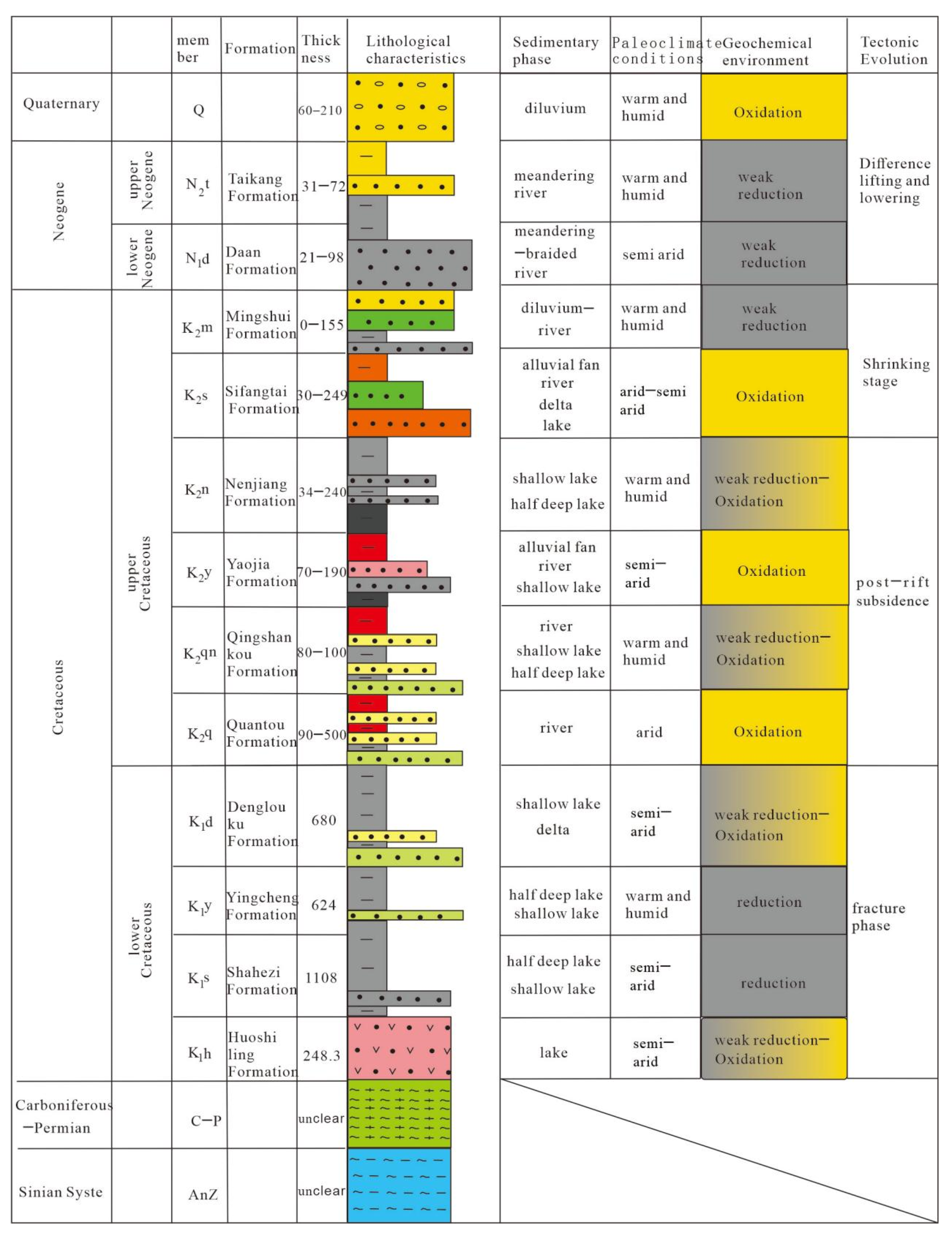
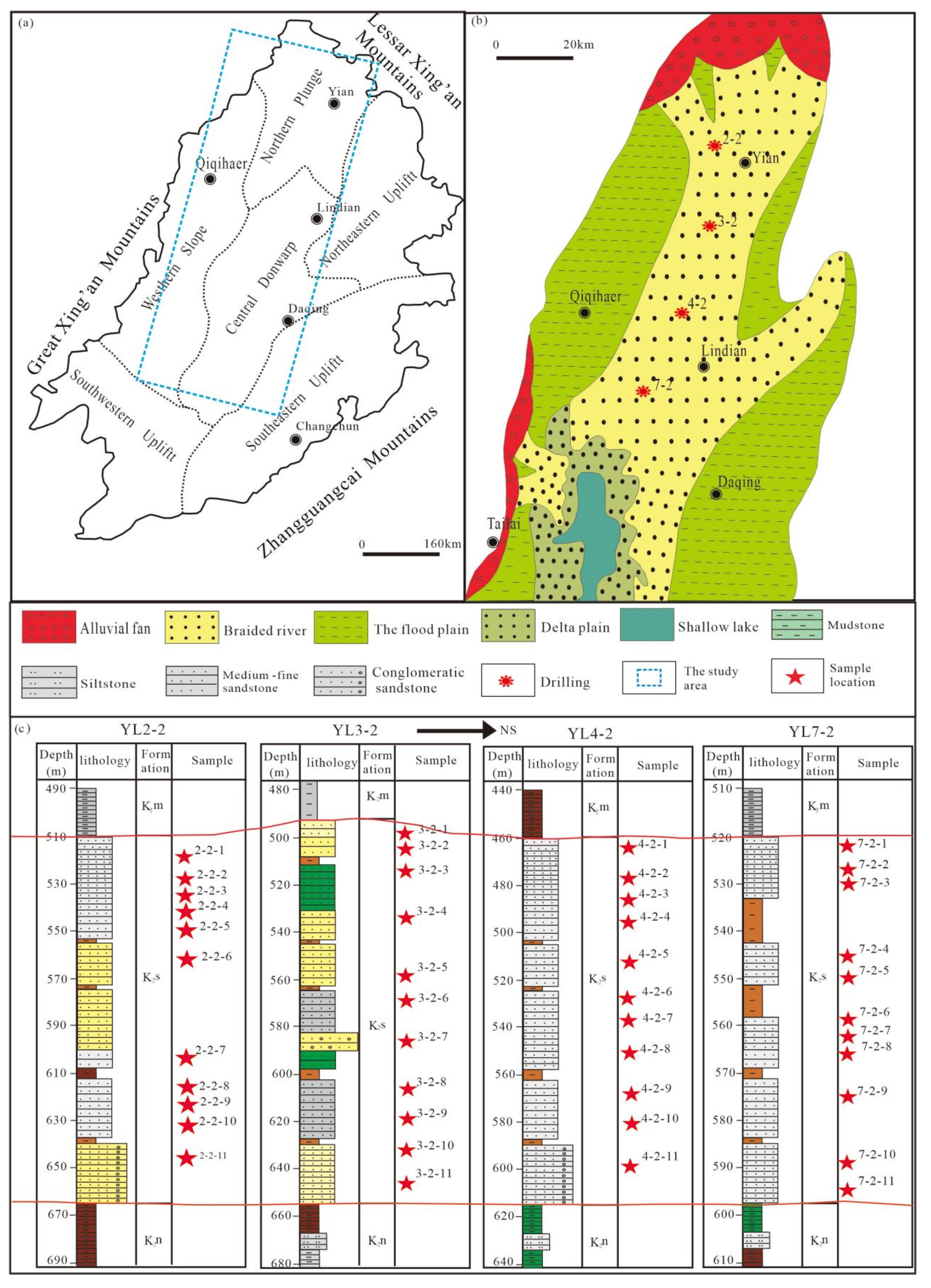
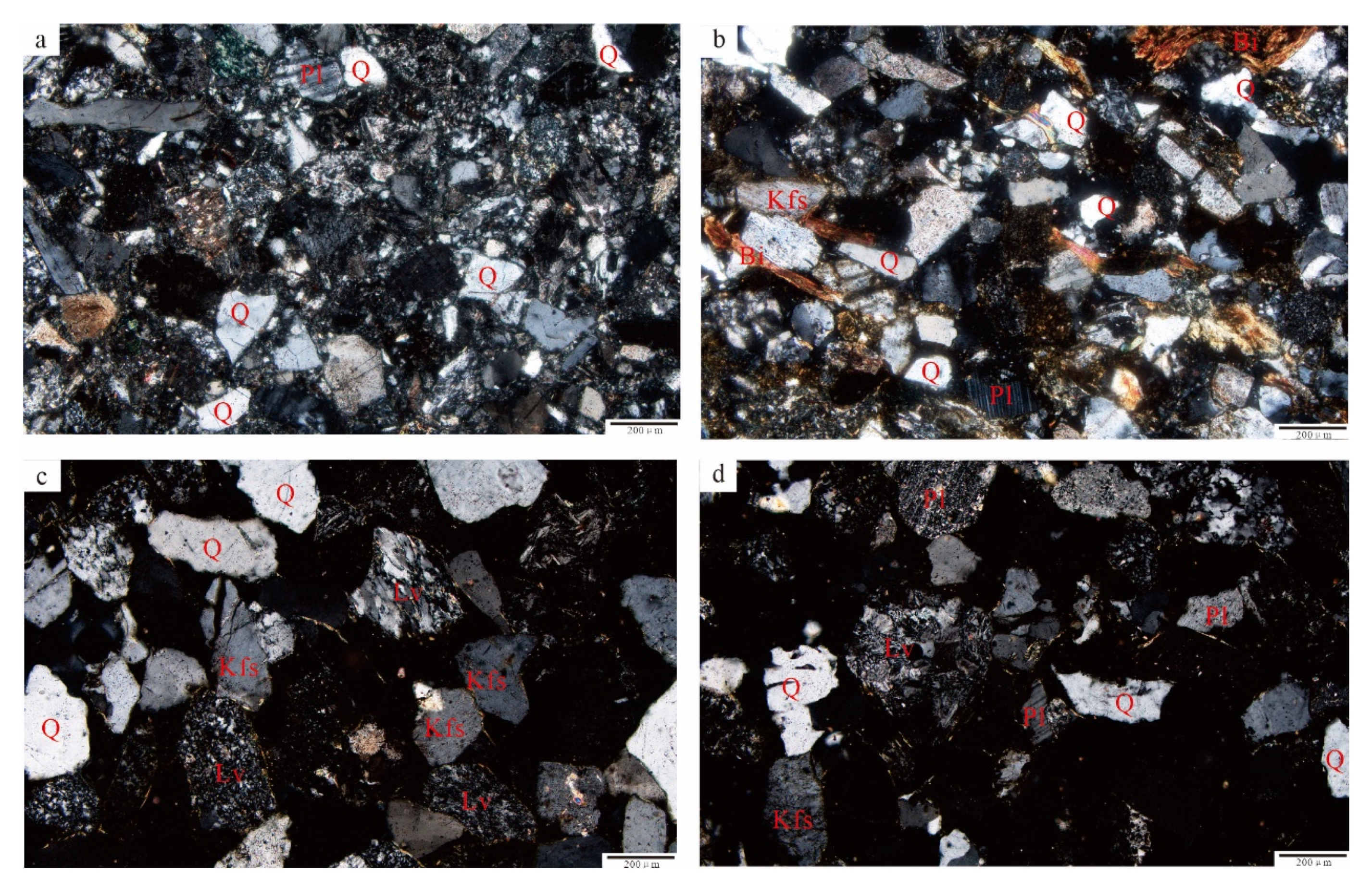
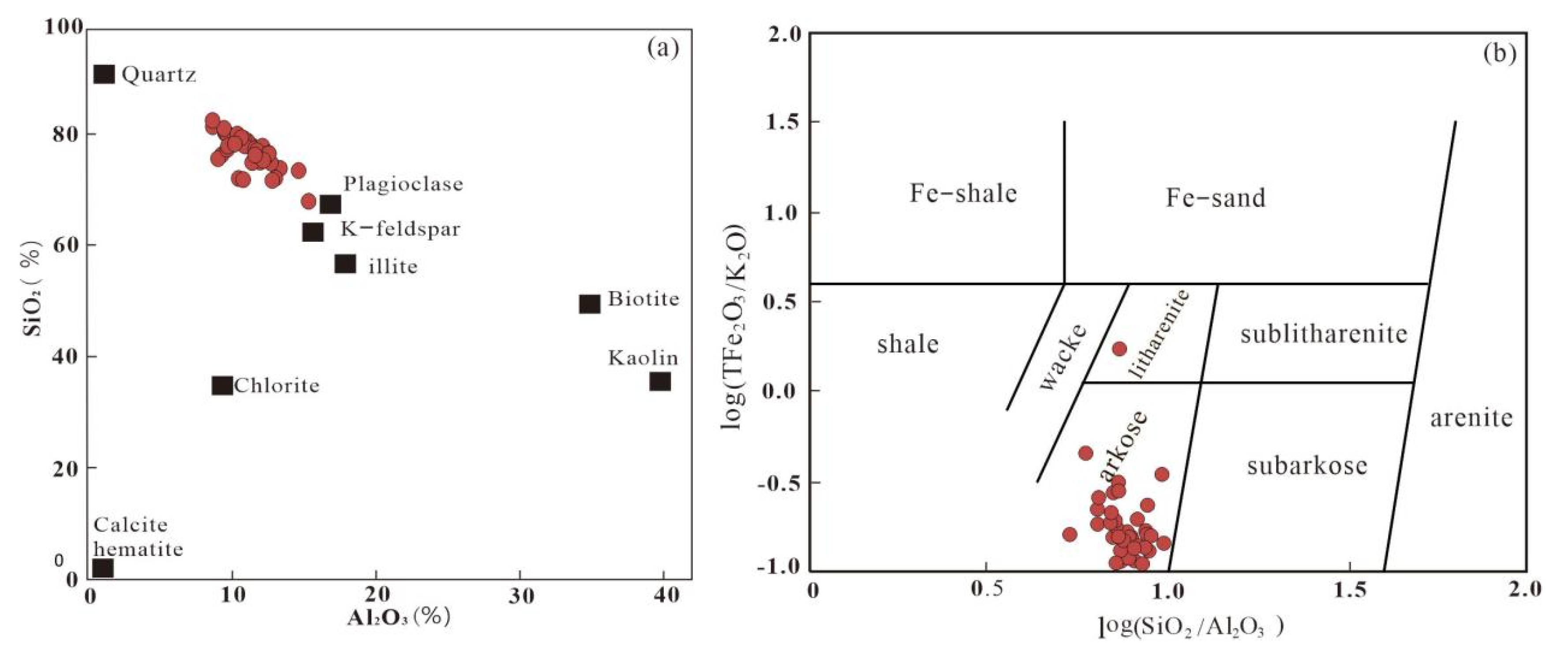
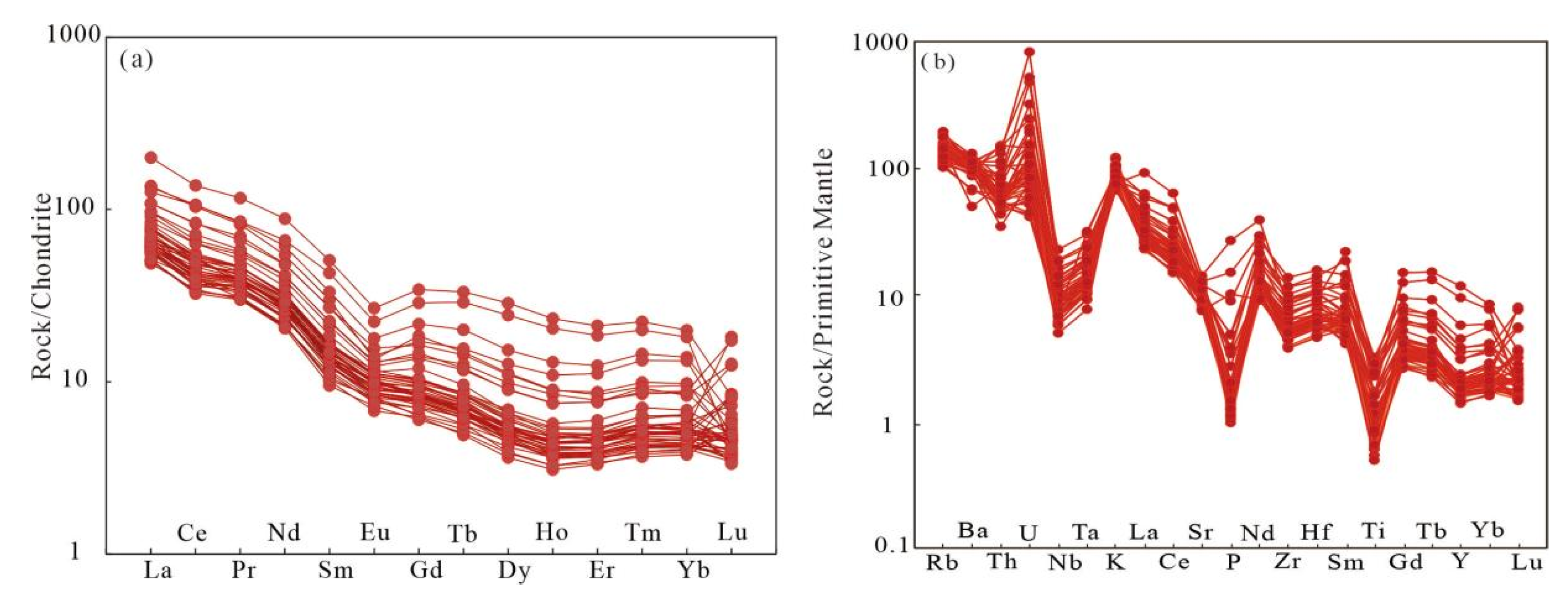
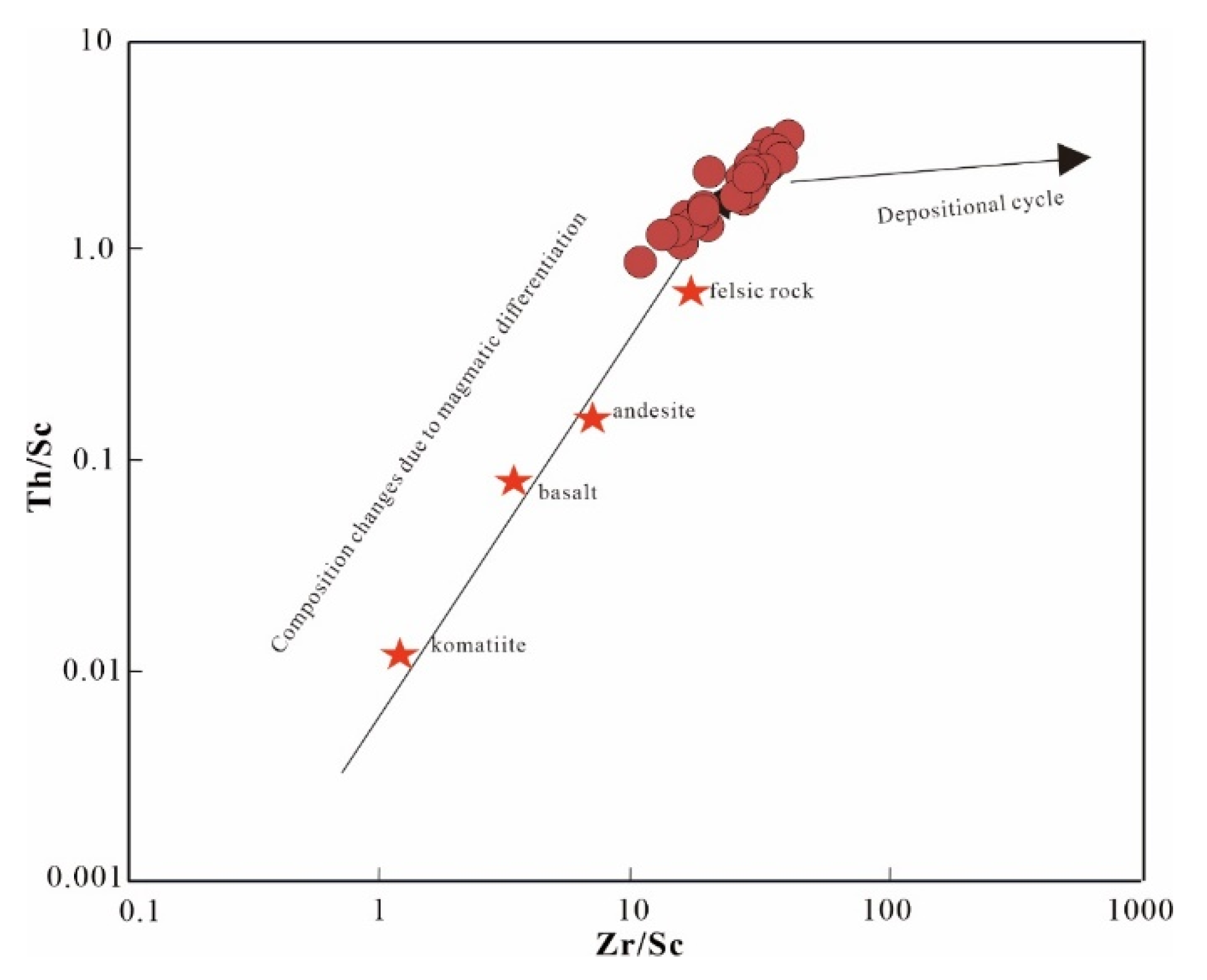
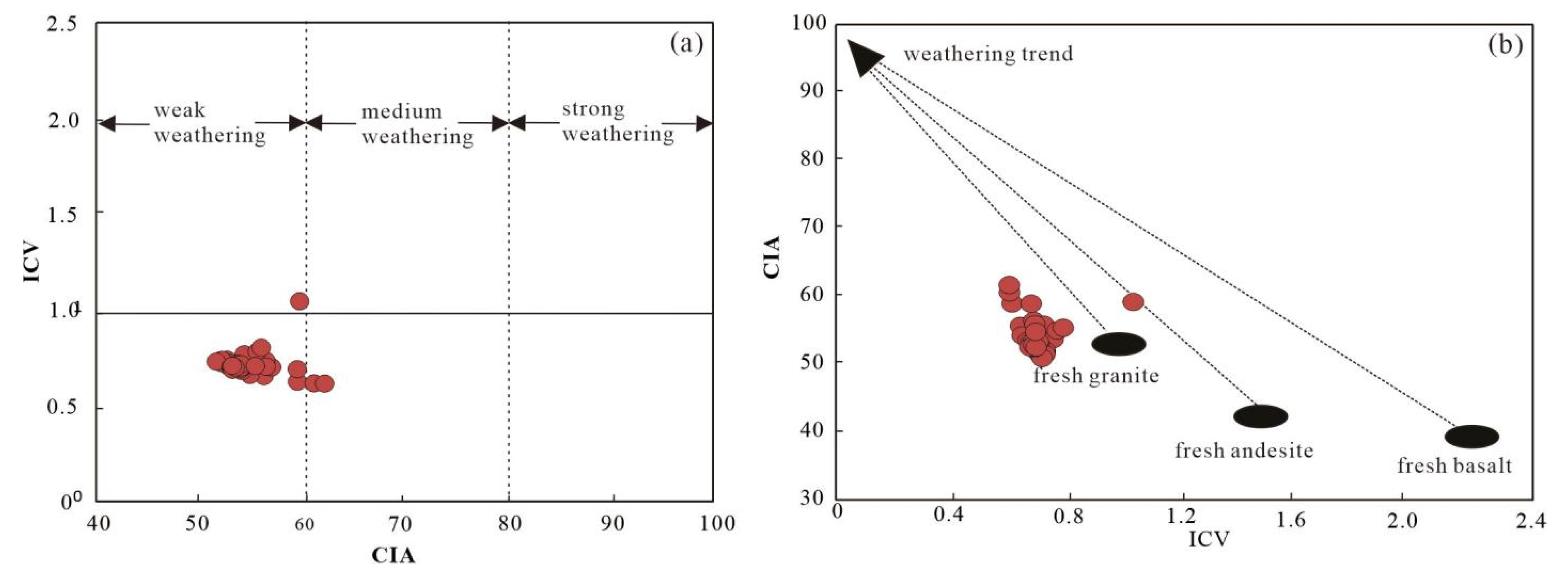
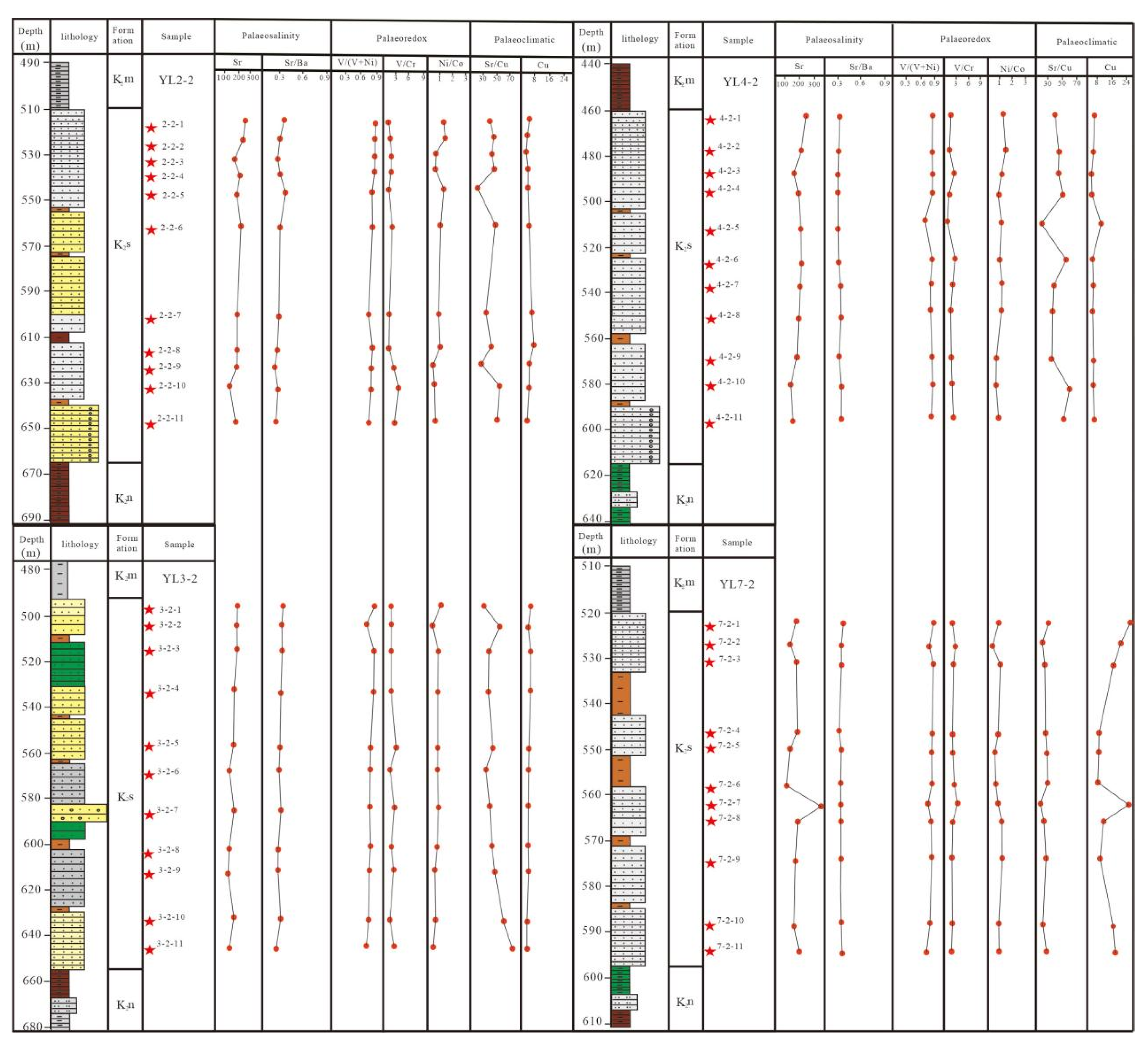
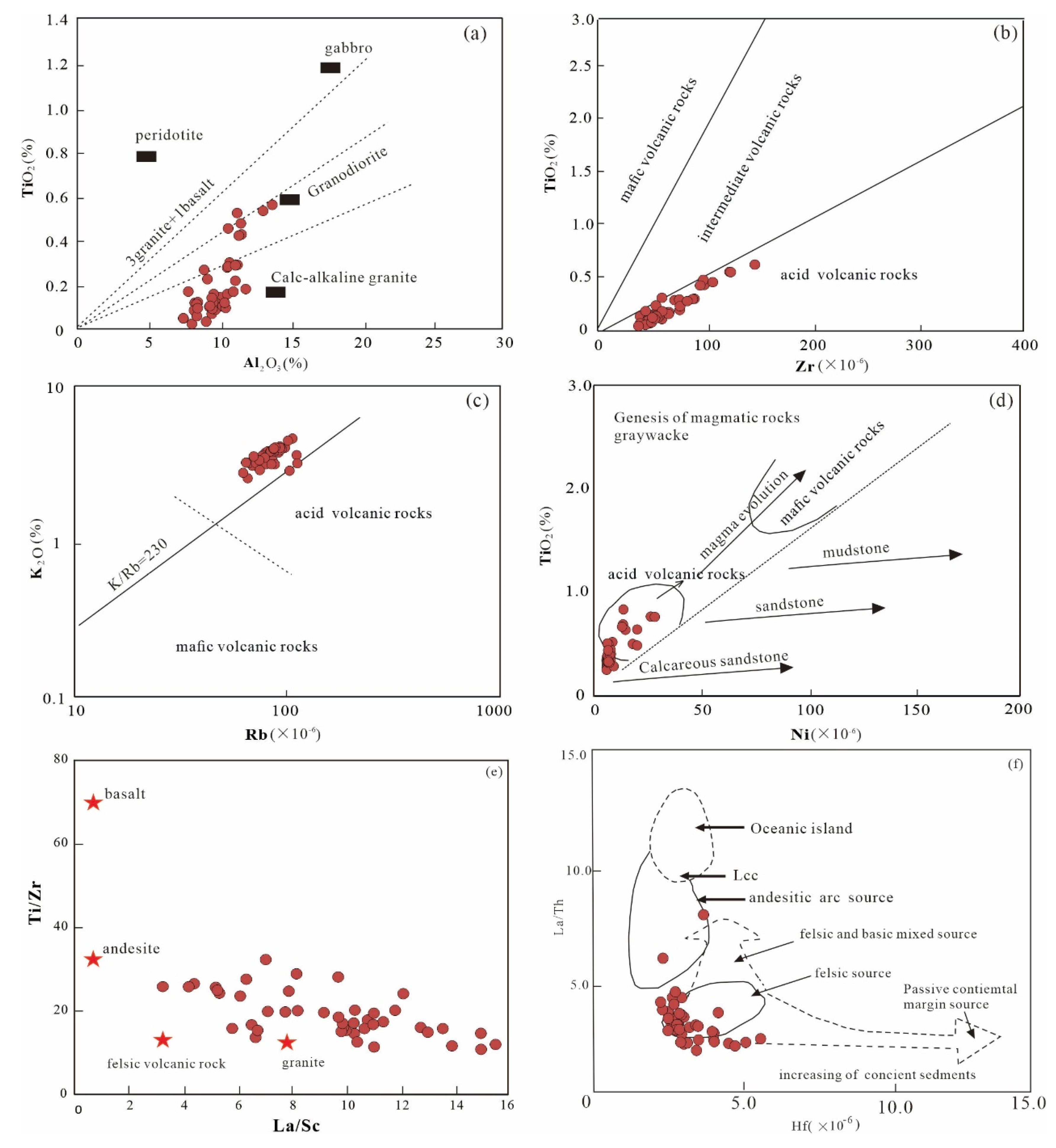
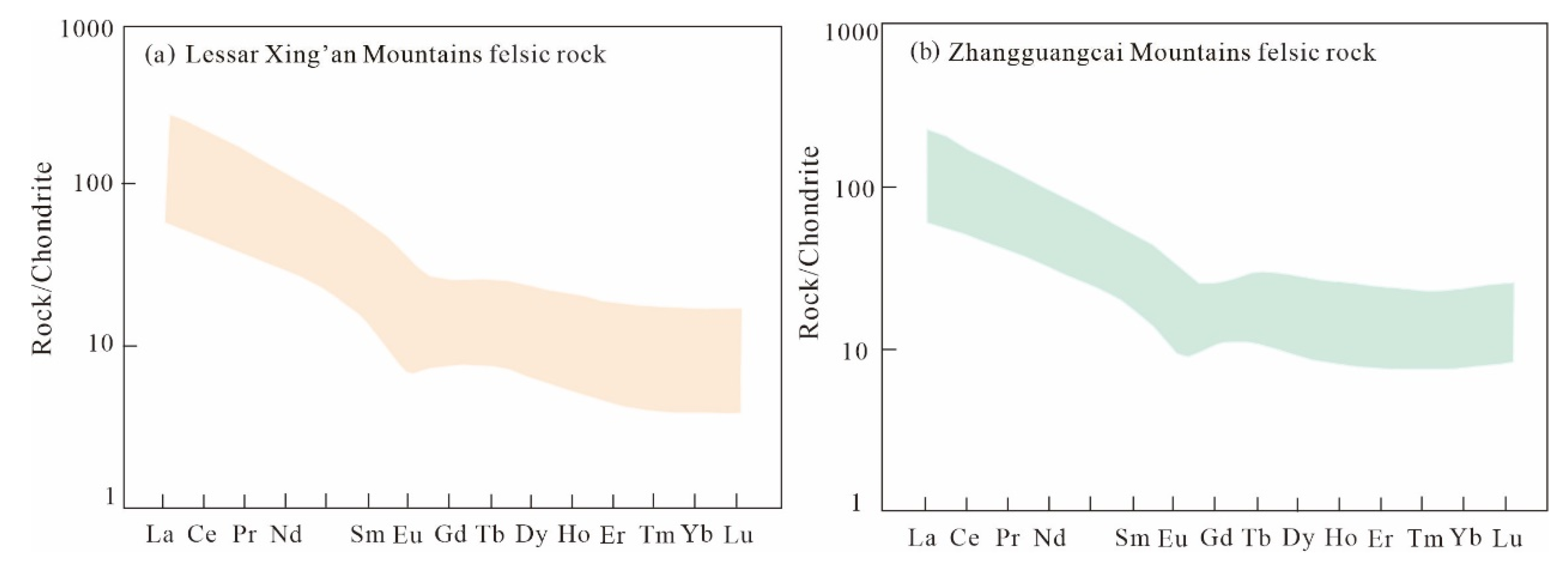

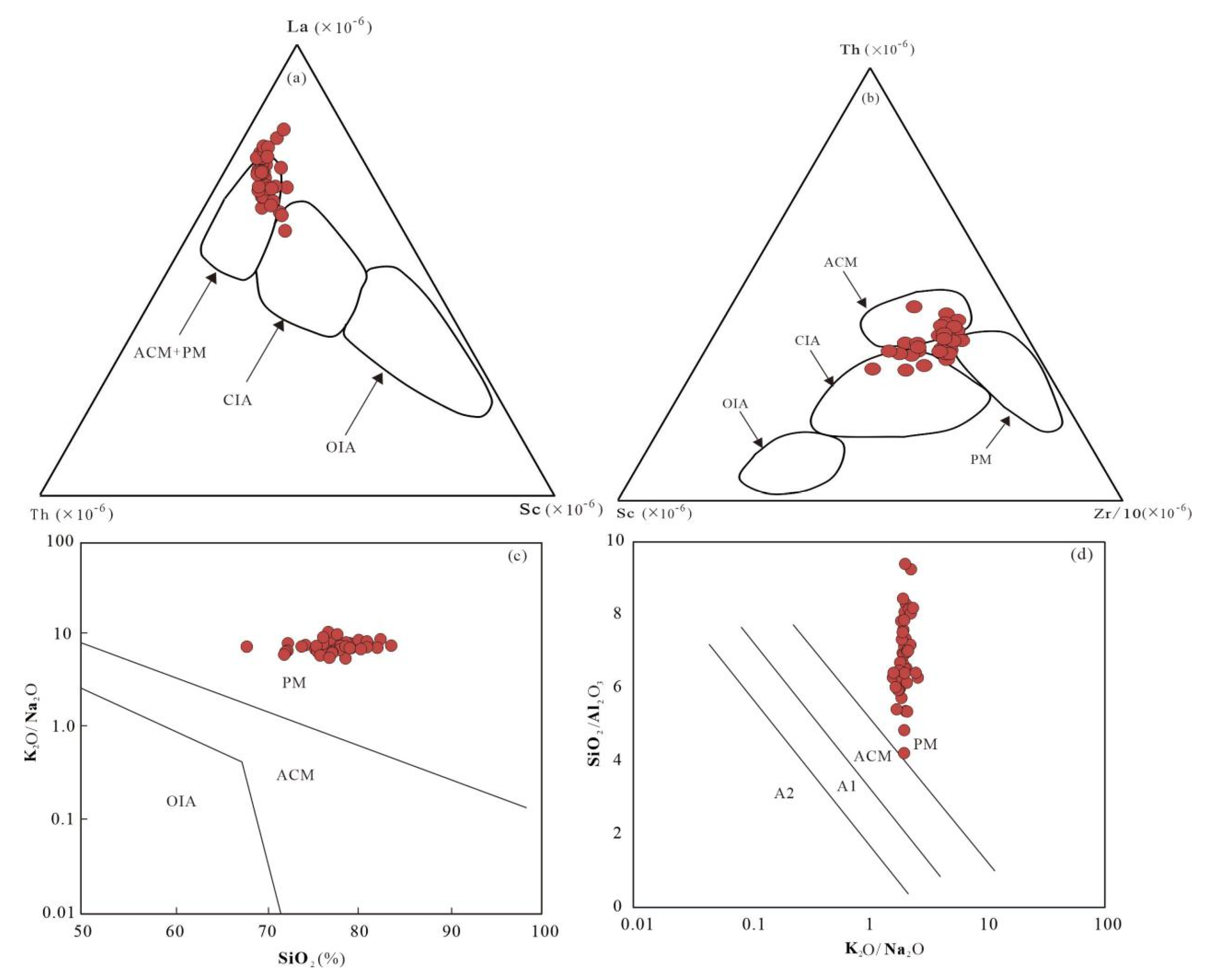
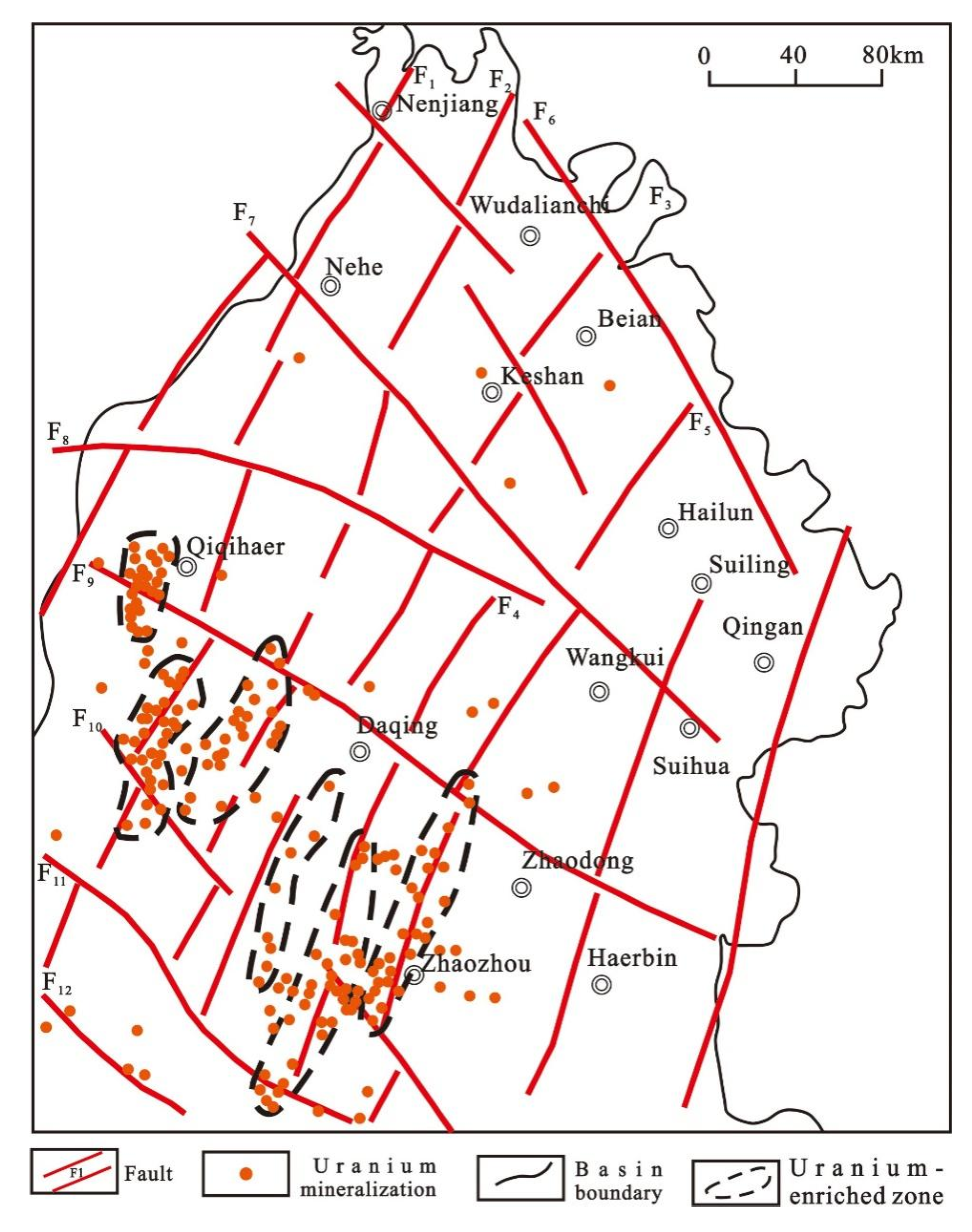
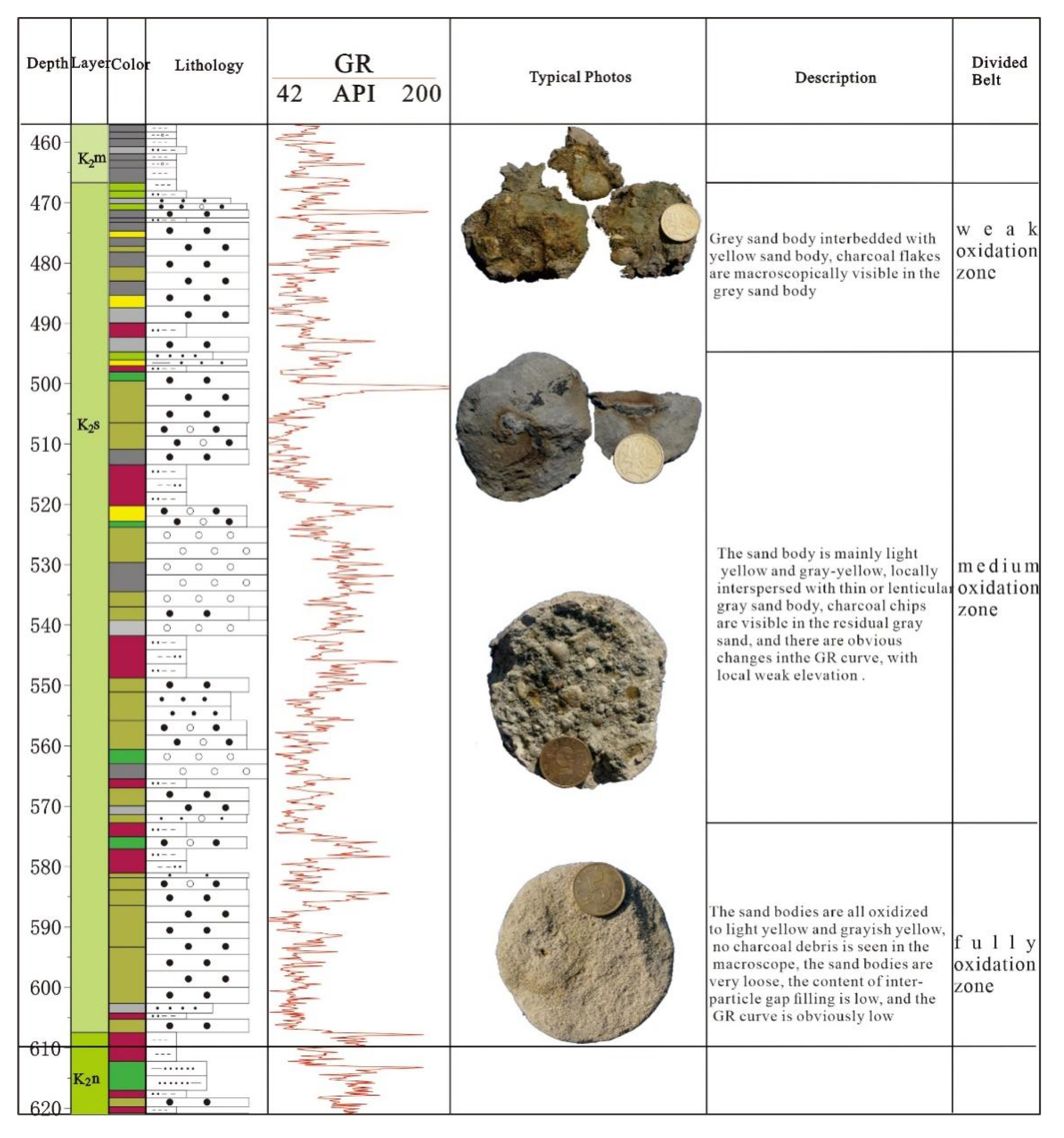
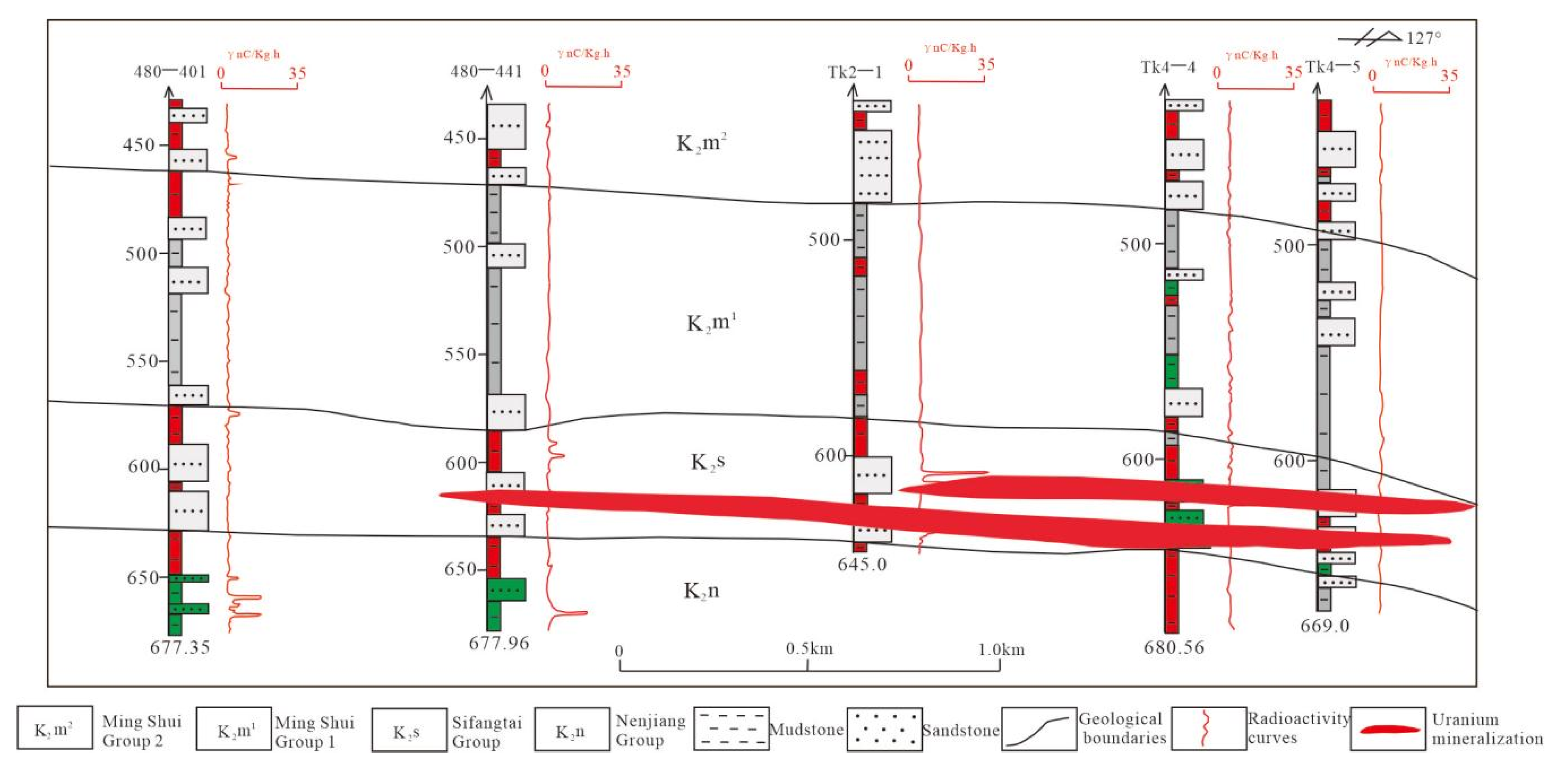

| No | SampleNo. | SiO2 | TiO2 | Al2O | TFe2O3 | MnO | CaO | MgO | Na2O | K2O | P2O5 | LOI | TOTAL | Na2O +K2O | SiO2/ Al2O3 | Na2O +Ca2O | 100MgO/ Al2O3 | CIA | ICV | ||
| 1 | Y4-2-1 | 74.52 | 0.26 | 13.16 | 0.65 | 0.03 | 0.54 | 0.35 | 3.05 | 3.52 | 0.02 | 2.94 | 99.04 | 6.57 | 5.66 | 3.59 | 2.68 | 56.13 | 0.64 | ||
| 2 | Y4-2-2 | 78.04 | 0.18 | 11.45 | 0.35 | 0.02 | 0.48 | 0.26 | 2.80 | 3.28 | 0.02 | 2.25 | 99.13 | 6.08 | 6.82 | 3.28 | 2.29 | 54.75 | 0.64 | ||
| 3 | Y4-2-3 | 82.46 | 0.13 | 8.72 | 1.03 | 0.03 | 0.38 | 0.21 | 2.10 | 2.69 | 0.02 | 1.55 | 99.32 | 4.79 | 9.46 | 2.48 | 2.42 | 54.18 | 0.75 | ||
| 4 | Y4-2-4 | 81.24 | 0.20 | 9.53 | 0.35 | 0.02 | 0.62 | 0.17 | 2.42 | 2.81 | 0.03 | 1.49 | 98.87 | 5.23 | 8.52 | 3.04 | 1.75 | 52.86 | 0.69 | ||
| 5 | Y4-2-5 | 72.65 | 0.50 | 12.86 | 0.65 | 0.06 | 0.84 | 0.60 | 2.38 | 2.83 | 0.05 | 4.46 | 97.88 | 5.21 | 5.65 | 3.22 | 4.68 | 59.40 | 0.61 | ||
| 6 | Y4-2-6 | 79.38 | 0.22 | 11.00 | 0.50 | 0.02 | 0.55 | 0.22 | 2.95 | 3.22 | 0.02 | 1.41 | 99.49 | 6.17 | 7.22 | 3.50 | 1.95 | 52.89 | 0.70 | ||
| 7 | Y4-2-7 | 78.82 | 0.23 | 11.31 | 0.50 | 0.01 | 0.60 | 0.23 | 3.05 | 3.32 | 0.05 | 1.46 | 99.57 | 6.37 | 6.97 | 3.65 | 2.00 | 52.81 | 0.70 | ||
| 8 | Y4-2-8 | 80.39 | 0.18 | 10.57 | 0.35 | 0.01 | 0.51 | 0.16 | 2.83 | 3.26 | 0.03 | 1.30 | 99.59 | 6.09 | 7.61 | 3.34 | 1.54 | 52.60 | 0.69 | ||
| 9 | Y4-2-9 | 75.56 | 0.37 | 12.57 | 0.30 | 0.02 | 0.64 | 0.33 | 3.24 | 3.46 | 0.03 | 2.04 | 98.55 | 6.70 | 6.01 | 3.88 | 2.60 | 53.96 | 0.66 | ||
| 10 | Y4-2-10 | 79.38 | 0.15 | 10.74 | 0.50 | 0.01 | 0.53 | 0.28 | 2.90 | 3.26 | 0.02 | 1.81 | 99.58 | 6.16 | 7.39 | 3.43 | 2.59 | 52.47 | 0.71 | ||
| 11 | Y4-2-11 | 78.89 | 0.17 | 11.01 | 0.55 | 0.02 | 0.53 | 0.27 | 3.00 | 3.34 | 0.01 | 1.78 | 99.57 | 6.34 | 7.17 | 3.53 | 2.47 | 52.39 | 0.71 | ||
| 12 | Y3-2-1 | 79.18 | 0.24 | 10.87 | 0.44 | 0.01 | 0.41 | 0.20 | 2.81 | 3.34 | 0.02 | 1.64 | 99.15 | 6.15 | 7.28 | 3.22 | 1.88 | 53.56 | 0.68 | ||
| 13 | Y3-2-2 | 79.74 | 0.20 | 11.01 | 0.40 | 0.01 | 0.41 | 0.15 | 3.03 | 3.59 | 0.02 | 1.32 | 99.87 | 6.62 | 7.24 | 3.44 | 1.40 | 52.17 | 0.71 | ||
| 14 | Y3-2-3 | 80.16 | 0.17 | 10.78 | 0.50 | 0.01 | 0.39 | 0.20 | 2.68 | 3.39 | 0.02 | 1.46 | 99.76 | 6.07 | 7.44 | 3.07 | 1.85 | 53.93 | 0.68 | ||
| 15 | Y3-2-4 | 78.82 | 0.20 | 10.84 | 0.50 | 0.02 | 0.44 | 0.24 | 2.71 | 3.28 | 0.02 | 2.38 | 99.45 | 5.99 | 7.27 | 3.15 | 2.24 | 53.98 | 0.68 | ||
| 16 | Y3-2-5 | 80.93 | 0.20 | 9.74 | 0.49 | 0.01 | 0.43 | 0.21 | 2.59 | 2.93 | 0.02 | 1.40 | 98.95 | 5.52 | 8.31 | 3.02 | 2.13 | 53.07 | 0.70 | ||
| 17 | Y3-2-6 | 81.02 | 0.19 | 9.66 | 0.50 | 0.01 | 0.39 | 0.17 | 2.56 | 3.16 | 0.02 | 1.60 | 99.29 | 5.72 | 8.39 | 2.95 | 1.73 | 52.51 | 0.72 | ||
| 18 | Y3-2-7 | 75.74 | 0.24 | 11.85 | 0.50 | 0.03 | 0.56 | 0.31 | 3.18 | 3.29 | 0.03 | 2.22 | 97.95 | 6.47 | 6.39 | 3.74 | 2.62 | 53.52 | 0.68 | ||
| 19 | Y3-2-8 | 82.13 | 0.17 | 9.47 | 0.45 | 0.01 | 0.41 | 0.16 | 2.64 | 2.90 | 0.02 | 1.41 | 99.77 | 5.54 | 8.67 | 3.05 | 1.67 | 52.32 | 0.71 | ||
| 20 | Y3-2-9 | 83.60 | 0.13 | 8.71 | 0.39 | 0.01 | 0.35 | 0.14 | 2.45 | 2.80 | 0.02 | 1.18 | 99.77 | 5.25 | 9.60 | 2.80 | 1.62 | 51.92 | 0.72 | ||
| 21 | Y3-2-10 | 78.25 | 0.19 | 11.52 | 0.44 | 0.02 | 0.45 | 0.25 | 3.09 | 3.51 | 0.02 | 1.48 | 99.22 | 6.6 | 6.79 | 3.54 | 2.20 | 53.07 | 0.69 | ||
| 22 | Y3-2-11 | 81.02 | 0.12 | 10.34 | 0.44 | 0.01 | 0.36 | 0.12 | 2.96 | 3.28 | 0.02 | 1.03 | 99.69 | 6.24 | 7.84 | 3.32 | 1.15 | 51.99 | 0.70 | ||
| 23 | Y2-2-1 | 78.75 | 0.38 | 12.01 | 0.50 | 0.04 | 0.93 | 0.33 | 3.12 | 2.82 | 0.04 | 0.60 | 99.52 | 5.94 | 6.56 | 4.05 | 2.76 | 53.78 | 0.67 | ||
| 24 | Y2-2-2 | 77.07 | 0.35 | 11.84 | 0.65 | 0.03 | 0.59 | 0.26 | 3.09 | 3.34 | 0.02 | 1.97 | 99.21 | 6.43 | 6.51 | 3.68 | 2.19 | 53.59 | 0.70 | ||
| 25 | Y2-2-3 | 77.11 | 0.11 | 9.32 | 0.40 | 0.01 | 0.40 | 0.19 | 2.41 | 3.07 | 0.02 | 1.04 | 94.07 | 5.48 | 8.27 | 2.81 | 2.03 | 52.65 | 0.71 | ||
| 26 | Y2-2-4 | 72.62 | 0.30 | 10.43 | 0.45 | 0.02 | 0.50 | 0.19 | 2.98 | 3.10 | 0.02 | 1.22 | 91.83 | 6.08 | 6.96 | 3.48 | 1.78 | 52.00 | 0.72 | ||
| 27 | Y2-2-5 | 72.39 | 0.22 | 10.74 | 5.43 | 1.66 | 0.52 | 0.48 | 2.19 | 2.23 | 0.03 | 3.47 | 99.35 | 4.42 | 6.74 | 2.71 | 4.43 | 59.61 | 1.03 | ||
| 28 | Y2-2-6 | 76.91 | 0.25 | 12.28 | 0.65 | 0.02 | 0.54 | 0.20 | 3.35 | 3.46 | 0.02 | 1.61 | 99.27 | 6.81 | 6.26 | 3.89 | 1.59 | 53.30 | 0.69 | ||
| 29 | Y2-2-7 | 76.39 | 0.36 | 11.90 | 0.85 | 0.02 | 0.88 | 0.68 | 2.45 | 2.90 | 0.07 | 3.03 | 99.53 | 5.35 | 6.42 | 3.33 | 5.71 | 56.87 | 0.68 | ||
| 30 | Y2-2-8 | 75.66 | 0.55 | 11.33 | 0.94 | 0.02 | 0.87 | 0.60 | 2.42 | 2.75 | 0.07 | 2.55 | 97.77 | 5.17 | 6.68 | 3.29 | 5.33 | 56.30 | 0.72 | ||
| 31 | Y2-2-9 | 76.93 | 0.18 | 11.73 | 0.42 | 0.01 | 0.37 | 0.20 | 2.77 | 4.04 | 0.02 | 1.65 | 98.32 | 6.81 | 6.56 | 3.14 | 1.73 | 53.86 | 0.68 | ||
| 32 | Y2-2-10 | 76.39 | 0.25 | 9.07 | 0.59 | 0.04 | 0.94 | 0.93 | 1.82 | 2.42 | 0.15 | 6.53 | 99.12 | 4.24 | 8.42 | 2.76 | 10.21 | 55.47 | 0.77 | ||
| 33 | Y2-2-11 | 77.89 | 0.20 | 11.65 | 0.60 | 0.02 | 0.39 | 0.24 | 2.79 | 3.91 | 0.02 | 1.60 | 99.30 | 6.7 | 6.69 | 3.18 | 2.03 | 53.90 | 0.70 | ||
| 34 | Y7-2-1 | 68.30 | 0.69 | 15.06 | 0.50 | 0.02 | 0.76 | 1.06 | 2.82 | 3.16 | 0.13 | 1.88 | 94.38 | 5.98 | 4.54 | 3.58 | 7.04 | 61.02 | 0.60 | ||
| 35 | Y7-2-2 | 78.13 | 0.14 | 9.68 | 0.30 | 0.01 | 0.39 | 0.17 | 2.86 | 3.03 | 0.02 | 1.97 | 96.70 | 5.89 | 8.07 | 3.25 | 1.75 | 51.44 | 0.71 | ||
| 36 | Y7-2-3 | 77.36 | 0.36 | 12.42 | 0.35 | 0.02 | 0.52 | 0.24 | 3.49 | 3.54 | 0.03 | 1.04 | 99.37 | 7.03 | 6.23 | 4.01 | 1.96 | 52.91 | 0.69 | ||
| 37 | Y7-2-4 | 77.35 | 0.30 | 12.42 | 0.25 | 0.01 | 0.54 | 0.27 | 3.48 | 3.48 | 0.03 | 1.22 | 99.33 | 6.96 | 6.23 | 4.02 | 2.15 | 53.03 | 0.67 | ||
| 38 | Y7-2-5 | 78.76 | 0.18 | 9.73 | 0.30 | 0.01 | 0.39 | 0.25 | 2.60 | 2.92 | 0.03 | 4.47 | 99.63 | 5.52 | 8.09 | 2.99 | 2.57 | 53.29 | 0.68 | ||
| 39 | Y7-2-6 | 80.38 | 0.19 | 10.61 | 0.40 | 0.01 | 0.47 | 0.28 | 2.89 | 3.10 | 0.02 | 1.61 | 99.96 | 5.99 | 7.58 | 3.36 | 2.67 | 53.01 | 0.69 | ||
| 40 | Y7-2-7 | 79.20 | 0.34 | 10.19 | 0.50 | 0.17 | 0.53 | 0.65 | 2.31 | 2.52 | 0.38 | 3.03 | 99.83 | 4.83 | 7.77 | 2.84 | 6.40 | 59.37 | 0.67 | ||
| 41 | Y7-2-8 | 72.27 | 0.49 | 12.66 | 0.75 | 0.02 | 0.97 | 0.89 | 2.83 | 2.75 | 0.03 | 2.55 | 96.21 | 5.58 | 5.71 | 3.80 | 7.05 | 56.34 | 0.69 | ||
| 42 | Y7-2-9 | 76.08 | 0.53 | 12.07 | 0.60 | 0.02 | 0.90 | 0.66 | 2.88 | 2.75 | 0.03 | 1.65 | 98.17 | 5.63 | 6.30 | 3.78 | 5.50 | 55.26 | 0.69 | ||
| 43 | Y7-2-10 | 74.10 | 0.62 | 14.39 | 1.46 | 0.03 | 0.77 | 0.46 | 2.48 | 2.79 | 0.06 | 2.53 | 99.69 | 5.27 | 5.15 | 3.25 | 3.20 | 62.07 | 0.60 | ||
| 44 | Y7-2-11 | 77.04 | 0.62 | 11.52 | 0.75 | 0.05 | 1.07 | 1.38 | 2.73 | 2.50 | 0.22 | 1.60 | 99.47 | 5.23 | 6.69 | 3.80 | 11.98 | 55.87 | 0.79 | ||
| No. | SampleNo. | PIA | La | Ce | Pr | Nd | Sm | Eu | Gd | Tb | Dy | Ho | Er | Tm | Yb | Lu | Y | ΣREE | LREE | HREE | LREE/HREE |
| 1 | Y4-2-1 | 59.08 | 17.70 | 32.00 | 3.79 | 13.90 | 2.35 | 0.58 | 1.98 | 0.31 | 1.69 | 0.33 | 0.97 | 0.18 | 1.12 | 0.11 | 9.24 | 77.00 | 70.32 | 6.68 | 10.53 |
| 2 | Y4-2-2 | 57.19 | 15.30 | 27.90 | 3.42 | 12.50 | 2.04 | 0.57 | 1.67 | 0.28 | 1.47 | 0.28 | 0.83 | 0.14 | 0.97 | 0.12 | 7.90 | 67.49 | 61.73 | 5.76 | 10.71 |
| 3 | Y4-2-3 | 56.54 | 15.80 | 27.20 | 3.50 | 12.60 | 1.94 | 0.49 | 1.62 | 0.24 | 1.18 | 0.23 | 0.71 | 0.12 | 0.81 | 0.27 | 6.31 | 66.71 | 61.53 | 5.18 | 11.87 |
| 4 | Y4-2-4 | 54.31 | 20.20 | 34.10 | 4.50 | 16.60 | 2.71 | 0.71 | 2.22 | 0.34 | 1.63 | 0.28 | 0.82 | 0.14 | 0.88 | 0.12 | 7.61 | 85.23 | 78.82 | 6.42 | 12.29 |
| 5 | Y4-2-5 | 63.11 | 34.00 | 67.30 | 7.92 | 28.80 | 5.17 | 1.13 | 4.23 | 0.70 | 3.57 | 0.66 | 1.85 | 0.32 | 2.03 | 0.15 | 17.20 | 157.83 | 144.32 | 13.51 | 10.68 |
| 6 | Y4-2-6 | 54.35 | 16.00 | 26.40 | 3.39 | 12.20 | 1.82 | 0.52 | 1.56 | 0.25 | 1.25 | 0.24 | 0.75 | 0.13 | 0.91 | 0.12 | 6.95 | 65.54 | 60.33 | 5.21 | 11.58 |
| 7 | Y4-2-7 | 54.23 | 18.00 | 30.00 | 4.13 | 15.80 | 2.50 | 0.62 | 2.04 | 0.32 | 1.64 | 0.31 | 0.88 | 0.16 | 0.98 | 0.19 | 8.43 | 77.57 | 71.05 | 6.52 | 10.90 |
| 8 | Y4-2-8 | 54.01 | 17.70 | 29.20 | 3.87 | 14.20 | 2.32 | 0.61 | 1.90 | 0.30 | 1.50 | 0.27 | 0.81 | 0.14 | 0.87 | 0.12 | 7.42 | 73.80 | 67.90 | 5.90 | 11.52 |
| 9 | Y4-2-9 | 55.84 | 24.40 | 41.30 | 5.24 | 19.20 | 3.22 | 0.80 | 2.62 | 0.43 | 2.14 | 0.40 | 1.15 | 0.20 | 1.34 | 0.13 | 10.50 | 102.58 | 94.16 | 8.41 | 11.19 |
| 10 | Y4-2-10 | 53.77 | 19.30 | 34.50 | 4.33 | 16.50 | 2.56 | 0.69 | 2.13 | 0.33 | 1.53 | 0.28 | 0.79 | 0.13 | 0.86 | 0.16 | 7.23 | 84.08 | 77.88 | 6.20 | 12.55 |
| 11 | Y4-2-11 | 53.65 | 18.80 | 33.60 | 4.28 | 17.10 | 2.59 | 0.75 | 2.16 | 0.33 | 1.59 | 0.29 | 0.83 | 0.14 | 0.90 | 0.13 | 7.76 | 83.49 | 77.12 | 6.37 | 12.11 |
| 12 | Y3-2-1 | 55.53 | 21.00 | 39.10 | 4.75 | 18.30 | 2.90 | 0.70 | 2.29 | 0.37 | 1.74 | 0.33 | 0.94 | 0.16 | 1.08 | 0.16 | 8.65 | 93.82 | 86.75 | 7.07 | 12.27 |
| 13 | Y3-2-2 | 53.43 | 19.60 | 37.80 | 4.51 | 16.20 | 2.69 | 0.72 | 2.13 | 0.33 | 1.59 | 0.30 | 0.89 | 0.15 | 0.95 | 0.15 | 8.39 | 88.01 | 81.52 | 6.49 | 12.56 |
| 14 | Y3-2-3 | 56.21 | 21.90 | 42.10 | 4.96 | 18.50 | 3.00 | 0.76 | 2.44 | 0.39 | 1.94 | 0.36 | 1.04 | 0.17 | 1.12 | 0.14 | 9.99 | 98.82 | 91.22 | 7.61 | 11.99 |
| 15 | Y3-2-4 | 56.16 | 23.60 | 42.90 | 5.23 | 19.40 | 3.17 | 0.78 | 2.52 | 0.37 | 1.83 | 0.33 | 0.98 | 0.16 | 1.07 | 0.15 | 8.79 | 102.49 | 95.08 | 7.41 | 12.83 |
| 16 | Y3-2-5 | 54.69 | 19.30 | 35.70 | 4.43 | 16.80 | 2.58 | 0.66 | 2.18 | 0.34 | 1.66 | 0.31 | 0.88 | 0.16 | 1.04 | 0.14 | 8.32 | 86.19 | 79.47 | 6.71 | 11.84 |
| 17 | Y3-2-6 | 54.00 | 21.70 | 40.00 | 4.76 | 17.80 | 2.93 | 0.73 | 2.40 | 0.37 | 1.77 | 0.33 | 0.95 | 0.16 | 1.02 | 0.13 | 8.85 | 95.03 | 87.92 | 7.12 | 12.35 |
| 18 | Y3-2-7 | 55.19 | 16.00 | 27.20 | 3.52 | 12.80 | 1.96 | 0.59 | 1.64 | 0.26 | 1.36 | 0.27 | 0.82 | 0.14 | 0.91 | 0.11 | 7.70 | 67.59 | 62.07 | 5.52 | 11.25 |
| 19 | Y3-2-8 | 53.55 | 19.60 | 32.40 | 4.19 | 15.30 | 2.38 | 0.60 | 1.98 | 0.30 | 1.44 | 0.28 | 0.83 | 0.14 | 0.89 | 0.13 | 7.54 | 80.45 | 74.47 | 5.98 | 12.45 |
| 20 | Y3-2-9 | 53.00 | 20.20 | 35.80 | 4.51 | 15.80 | 2.63 | 0.64 | 2.25 | 0.32 | 1.47 | 0.27 | 0.78 | 0.13 | 0.85 | 0.11 | 7.07 | 85.75 | 79.58 | 6.17 | 12.90 |
| 21 | Y3-2-10 | 54.73 | 20.50 | 34.50 | 4.44 | 16.20 | 2.52 | 0.65 | 2.20 | 0.33 | 1.54 | 0.30 | 0.86 | 0.15 | 0.95 | 0.16 | 8.12 | 85.29 | 78.81 | 6.49 | 12.15 |
| 22 | Y3-2-11 | 53.10 | 18.70 | 30.00 | 4.00 | 14.20 | 2.22 | 0.57 | 1.82 | 0.28 | 1.27 | 0.24 | 0.72 | 0.12 | 0.78 | 0.17 | 6.51 | 75.09 | 69.69 | 5.40 | 12.90 |
| 23 | Y2-2-1 | 55.21 | 23.10 | 38.40 | 4.96 | 18.30 | 3.08 | 0.78 | 2.56 | 0.41 | 2.00 | 0.37 | 1.06 | 0.18 | 1.17 | 0.11 | 9.28 | 96.48 | 88.62 | 7.85 | 11.28 |
| 24 | Y2-2-2 | 55.34 | 21.10 | 35.60 | 4.52 | 17.00 | 2.72 | 0.66 | 2.24 | 0.36 | 1.78 | 0.36 | 1.04 | 0.18 | 1.20 | 0.15 | 9.53 | 88.90 | 81.60 | 7.30 | 11.18 |
| 25 | Y2-2-3 | 54.24 | 18.30 | 31.30 | 3.99 | 13.80 | 2.38 | 0.61 | 1.98 | 0.30 | 1.53 | 0.28 | 0.77 | 0.13 | 0.83 | 0.17 | 7.37 | 76.37 | 70.38 | 5.99 | 11.75 |
| 26 | Y2-2-4 | 53.00 | 18.90 | 32.40 | 3.97 | 15.00 | 2.47 | 0.63 | 2.08 | 0.33 | 1.77 | 0.35 | 0.99 | 0.17 | 1.11 | 0.15 | 9.30 | 80.32 | 73.37 | 6.96 | 10.54 |
| 27 | Y2-2-5 | 63.12 | 18.80 | 33.20 | 4.28 | 15.40 | 2.60 | 0.62 | 2.09 | 0.35 | 1.80 | 0.35 | 1.00 | 0.18 | 1.21 | 0.24 | 9.74 | 82.11 | 74.90 | 7.22 | 10.38 |
| 28 | Y2-2-6 | 54.89 | 17.40 | 30.10 | 3.72 | 14.40 | 2.33 | 0.63 | 2.00 | 0.32 | 1.61 | 0.33 | 0.94 | 0.17 | 1.08 | 0.27 | 8.93 | 75.29 | 68.58 | 6.72 | 10.21 |
| 29 | Y2-2-7 | 59.82 | 30.30 | 54.00 | 6.38 | 24.60 | 4.30 | 0.94 | 3.63 | 0.62 | 3.20 | 0.62 | 1.66 | 0.27 | 1.80 | 0.16 | 16.00 | 132.49 | 120.52 | 11.96 | 10.07 |
| 30 | Y2-2-8 | 58.95 | 43.10 | 84.30 | 9.25 | 32.40 | 5.72 | 0.97 | 4.79 | 0.73 | 3.64 | 0.67 | 1.79 | 0.30 | 1.98 | 0.19 | 17.40 | 189.83 | 175.74 | 14.09 | 12.47 |
| 31 | Y2-2-9 | 56.44 | 19.40 | 42.10 | 4.28 | 15.40 | 2.60 | 0.73 | 2.13 | 0.35 | 1.74 | 0.33 | 0.98 | 0.16 | 1.06 | 0.15 | 8.49 | 91.41 | 84.51 | 6.89 | 12.26 |
| 32 | Y2-2-10 | 58.05 | 16.20 | 32.30 | 3.47 | 12.40 | 2.15 | 0.55 | 1.83 | 0.31 | 1.67 | 0.34 | 1.06 | 0.20 | 1.34 | 0.40 | 10.70 | 74.22 | 67.07 | 7.15 | 9.38 |
| 33 | Y2-2-11 | 56.41 | 20.60 | 42.40 | 4.45 | 16.50 | 2.79 | 0.74 | 2.20 | 0.35 | 1.71 | 0.32 | 0.98 | 0.16 | 1.02 | 0.15 | 8.41 | 94.37 | 87.48 | 6.89 | 12.70 |
| 34 | Y7-2-1 | 65.24 | 42.30 | 86.50 | 9.48 | 36.50 | 6.36 | 1.29 | 5.61 | 0.98 | 4.96 | 0.96 | 2.64 | 0.47 | 2.88 | 0.21 | 26.10 | 201.14 | 182.43 | 18.71 | 9.75 |
| 35 | Y7-2-2 | 52.21 | 24.40 | 44.10 | 5.27 | 19.40 | 3.13 | 0.81 | 2.67 | 0.41 | 1.95 | 0.36 | 0.98 | 0.16 | 1.05 | 0.18 | 8.95 | 104.87 | 97.11 | 7.77 | 12.51 |
| 36 | Y7-2-3 | 54.32 | 25.80 | 45.10 | 5.30 | 18.80 | 3.12 | 0.84 | 2.70 | 0.42 | 2.24 | 0.42 | 1.27 | 0.23 | 1.42 | 0.16 | 10.60 | 107.82 | 98.96 | 8.86 | 11.17 |
| 37 | Y7-2-4 | 54.46 | 24.70 | 43.10 | 5.23 | 18.90 | 3.07 | 0.80 | 2.70 | 0.42 | 2.05 | 0.39 | 1.12 | 0.20 | 1.31 | 0.14 | 9.75 | 104.14 | 95.80 | 8.34 | 11.49 |
| 38 | Y7-2-5 | 55.03 | 26.60 | 51.60 | 5.83 | 21.20 | 3.56 | 0.82 | 3.10 | 0.47 | 2.15 | 0.37 | 1.06 | 0.18 | 1.11 | 0.59 | 9.13 | 118.65 | 109.61 | 9.04 | 12.13 |
| 39 | Y7-2-6 | 54.53 | 22.10 | 40.00 | 4.69 | 17.30 | 2.83 | 0.71 | 2.43 | 0.38 | 1.79 | 0.32 | 0.95 | 0.17 | 1.03 | 0.26 | 8.23 | 94.96 | 87.63 | 7.33 | 11.96 |
| 40 | Y7-2-7 | 63.74 | 62.90 | 112.00 | 13.20 | 52.70 | 9.70 | 1.93 | 8.88 | 1.63 | 9.29 | 1.72 | 4.49 | 0.72 | 4.13 | 0.27 | 53.20 | 283.55 | 252.43 | 31.12 | 8.11 |
| 41 | Y7-2-8 | 58.63 | 28.70 | 51.60 | 6.20 | 23.20 | 4.04 | 0.89 | 3.54 | 0.57 | 2.94 | 0.56 | 1.62 | 0.30 | 1.73 | 0.41 | 14.20 | 126.30 | 114.63 | 11.67 | 9.82 |
| 42 | Y7-2-9 | 57.24 | 30.50 | 58.20 | 6.62 | 24.70 | 4.28 | 0.93 | 3.80 | 0.59 | 2.92 | 0.56 | 1.62 | 0.28 | 1.82 | 0.56 | 14.00 | 137.37 | 125.23 | 12.14 | 10.31 |
| 43 | Y7-2-10 | 66.33 | 34.10 | 67.80 | 7.49 | 28.60 | 5.19 | 1.02 | 4.46 | 0.76 | 4.12 | 0.81 | 2.37 | 0.43 | 2.75 | 0.16 | 20.40 | 160.06 | 144.20 | 15.86 | 9.09 |
| 44 | Y7-2-11 | 57.95 | 39.70 | 85.90 | 9.64 | 39.50 | 8.20 | 1.61 | 7.44 | 1.42 | 7.92 | 1.51 | 3.95 | 0.64 | 3.77 | 0.13 | 43.00 | 211.33 | 184.55 | 26.78 | 6.89 |
| No. | SampleNo. | LaN/YbN | LaN/SmN | GdN/YbN | δEu | δCe | Rb | Ba | Th | U | Nb | Ta | Sr | Zr | Hf | V | Co | Cu | Cr | Ti | |
| 1 | Y4-2-1 | 11.34 | 4.58 | 1.42 | 0.82 | 0.96 | 106 | 776 | 6.14 | 1.75 | 7.08 | 0.592 | 238 | 81.6 | 2.64 | 24.80 | 3.02 | 6.20 | 9.12 | 1556 | |
| 2 | Y4-2-2 | 11.37 | 4.56 | 1.39 | 0.94 | 0.95 | 98.3 | 756 | 4.84 | 1.47 | 5.35 | 0.46 | 225 | 64.8 | 2.21 | 17.60 | 1.24 | 4.75 | 8.06 | 1101 | |
| 3 | Y4-2-3 | 13.96 | 4.96 | 1.60 | 0.84 | 0.90 | 71.9 | 607 | 4.02 | 1.26 | 4.39 | 0.418 | 161 | 52.9 | 1.84 | 15.20 | 1.68 | 3.59 | 5.11 | 784 | |
| 4 | Y4-2-4 | 16.56 | 4.54 | 2.03 | 0.88 | 0.88 | 69.1 | 643 | 2.94 | 1.62 | 4.82 | 0.429 | 204 | 44.1 | 1.5 | 14.70 | 1.71 | 3.87 | 7.41 | 1191 | |
| 5 | Y4-2-5 | 12.01 | 4.00 | 1.67 | 0.74 | 1.01 | 88.8 | 694 | 7.53 | 9.99 | 10.8 | 0.856 | 236 | 105 | 3.38 | 47.00 | 12.20 | 13.30 | 27.00 | 2986 | |
| 6 | Y4-2-6 | 12.65 | 5.35 | 1.38 | 0.95 | 0.88 | 84.2 | 702 | 4.13 | 1.13 | 6.32 | 0.546 | 229 | 57.7 | 1.96 | 21.80 | 1.69 | 4.15 | 5.37 | 1335 | |
| 7 | Y4-2-7 | 13.13 | 4.38 | 1.66 | 0.84 | 0.85 | 86.5 | 746 | 4.46 | 1.08 | 6.39 | 0.544 | 228 | 59.3 | 2.03 | 16.00 | 2.13 | 5.07 | 5.21 | 1347 | |
| 8 | Y4-2-8 | 14.64 | 4.64 | 1.75 | 0.89 | 0.87 | 83.7 | 739 | 4.23 | 0.906 | 5.01 | 0.432 | 212 | 51.9 | 1.76 | 14.60 | 1.62 | 4.39 | 4.99 | 1089 | |
| 9 | Y4-2-9 | 13.06 | 4.61 | 1.57 | 0.85 | 0.90 | 102 | 827 | 6.71 | 1.45 | 9.68 | 0.784 | 256 | 95.5 | 3.23 | 25.50 | 3.44 | 6.68 | 11.00 | 2190 | |
| 10 | Y4-2-10 | 16.04 | 4.59 | 1.98 | 0.90 | 0.93 | 85.8 | 762 | 4.31 | 0.868 | 4.74 | 0.416 | 230 | 50.4 | 1.68 | 13.70 | 2.18 | 3.57 | 5.38 | 904 | |
| 11 | Y4-2-11 | 14.93 | 4.42 | 1.92 | 0.97 | 0.92 | 86.2 | 794 | 4.59 | 0.929 | 5.56 | 0.478 | 243 | 54.4 | 1.77 | 14.50 | 2.23 | 3.97 | 5.64 | 1011 | |
| 12 | Y3-2-1 | 13.95 | 4.41 | 1.70 | 0.83 | 0.96 | 91.4 | 742 | 5.41 | 1.58 | 6.82 | 0.588 | 210 | 70.2 | 2.4 | 14.50 | 1.52 | 4.95 | 5.68 | 1424 | |
| 13 | Y3-2-2 | 14.80 | 4.43 | 1.80 | 0.92 | 0.99 | 99.8 | 771 | 4.59 | 1.67 | 5.91 | 0.514 | 218 | 58.1 | 1.97 | 12.10 | 7.78 | 3.61 | 4.68 | 1197 | |
| 14 | Y3-2-3 | 14.03 | 4.44 | 1.74 | 0.86 | 0.99 | 99.6 | 798 | 5.07 | 1.87 | 5.61 | 0.473 | 208 | 64.7 | 2.21 | 15.30 | 2.71 | 4.81 | 6.00 | 1035 | |
| 15 | Y3-2-4 | 15.82 | 4.53 | 1.89 | 0.84 | 0.95 | 92.4 | 763 | 5.33 | 1.62 | 6.02 | 0.55 | 209 | 62.4 | 2.12 | 18.60 | 2.30 | 4.65 | 6.80 | 1209 | |
| 16 | Y3-2-5 | 13.31 | 4.55 | 1.68 | 0.86 | 0.95 | 79.9 | 721 | 4.56 | 1.41 | 6.39 | 0.549 | 198 | 53.6 | 1.79 | 17.00 | 1.66 | 3.53 | 4.99 | 1209 | |
| 17 | Y3-2-6 | 15.26 | 4.51 | 1.88 | 0.84 | 0.96 | 81.6 | 688 | 4.84 | 2.41 | 5.51 | 0.487 | 179 | 60.2 | 2.05 | 13.40 | 1.92 | 3.75 | 6.23 | 1161 | |
| 18 | Y3-2-7 | 12.60 | 4.97 | 1.44 | 1.00 | 0.89 | 88.7 | 796 | 4.99 | 1.24 | 6.56 | 0.546 | 241 | 71.6 | 2.33 | 24.40 | 1.88 | 4.45 | 7.46 | 1424 | |
| 19 | Y3-2-8 | 15.87 | 5.01 | 1.79 | 0.85 | 0.88 | 78.2 | 686 | 4.3 | 1.99 | 5.1 | 0.44 | 194 | 52.2 | 1.68 | 11.80 | 1.81 | 3.61 | 4.36 | 993 | |
| 20 | Y3-2-9 | 17.13 | 4.67 | 2.13 | 0.81 | 0.92 | 75 | 669 | 4.35 | 2 | 4.09 | 0.374 | 175 | 44 | 1.48 | 11.40 | 2.04 | 3.24 | 3.57 | 790 | |
| 21 | Y3-2-10 | 15.54 | 4.95 | 1.86 | 0.84 | 0.89 | 100 | 832 | 5.13 | 1.91 | 5.61 | 0.489 | 232 | 60.6 | 2.01 | 14.90 | 2.41 | 3.88 | 5.20 | 1113 | |
| 22 | Y3-2-11 | 17.11 | 5.13 | 1.86 | 0.86 | 0.85 | 90.4 | 776 | 4.38 | 2.29 | 4.12 | 0.378 | 214 | 49 | 1.68 | 9.61 | 4.06 | 2.85 | 2.63 | 700 | |
| 23 | Y2-2-1 | 14.16 | 4.56 | 1.75 | 0.85 | 0.88 | 66.6 | 649 | 4.47 | 2.68 | 7.63 | 0.604 | 282 | 64.7 | 2.14 | 28.80 | 3.81 | 5.86 | 14.50 | 2250 | |
| 24 | Y2-2-2 | 12.61 | 4.72 | 1.49 | 0.82 | 0.89 | 89.5 | 784 | 6.32 | 1.63 | 9.12 | 0.754 | 242 | 76.8 | 2.71 | 23.10 | 2.10 | 4.73 | 8.41 | 2119 | |
| 25 | Y2-2-3 | 15.80 | 4.68 | 1.91 | 0.86 | 0.90 | 79.5 | 682 | 3.68 | 1.22 | 3.54 | 0.314 | 180 | 42.4 | 1.42 | 10.00 | 1.96 | 2.88 | 4.10 | 640 | |
| 26 | Y2-2-4 | 12.21 | 4.66 | 1.50 | 0.84 | 0.92 | 80.2 | 678 | 4.73 | 3.4 | 7.87 | 0.67 | 215 | 58.9 | 1.98 | 17.10 | 4.78 | 4.38 | 6.60 | 1813 | |
| 27 | Y2-2-5 | 11.14 | 4.40 | 1.38 | 0.81 | 0.91 | 67.9 | 462 | 5.25 | 1.67 | 6.11 | 0.477 | 190 | 71 | 2.13 | 18.60 | 1.89 | 5.33 | 10.50 | 1323 | |
| 28 | Y2-2-6 | 11.56 | 4.54 | 1.48 | 0.89 | 0.92 | 92.4 | 783 | 5.38 | 2.52 | 6.93 | 0.554 | 259 | 65 | 2.1 | 16.90 | 2.33 | 4.44 | 6.27 | 1484 | |
| 29 | Y2-2-7 | 12.07 | 4.29 | 1.61 | 0.73 | 0.95 | 91.6 | 710 | 7.61 | 3.23 | 8.63 | 0.651 | 227 | 81.2 | 2.61 | 38.60 | 10.30 | 6.36 | 25.40 | 2149 | |
| 30 | Y2-2-8 | 15.61 | 4.58 | 1.94 | 0.57 | 1.04 | 84.3 | 665 | 12.8 | 3.03 | 11.6 | 0.847 | 214 | 104 | 3.22 | 43.50 | 6.56 | 7.32 | 33.80 | 3280 | |
| 31 | Y2-2-9 | 13.13 | 4.54 | 1.61 | 0.95 | 1.13 | 116 | 881 | 5.15 | 2.1 | 5.55 | 0.486 | 214 | 55.7 | 1.95 | 17.40 | 5.58 | 3.68 | 4.67 | 1059 | |
| 32 | Y2-2-10 | 8.67 | 4.58 | 1.09 | 0.84 | 1.06 | 64.3 | 477 | 4.33 | 2.18 | 5.99 | 0.485 | 158 | 49.2 | 1.67 | 36.80 | 7.98 | 4.08 | 7.62 | 1490 | |
| 33 | Y2-2-11 | 14.49 | 4.49 | 1.73 | 0.91 | 1.09 | 110 | 836 | 5.44 | 2.06 | 6.22 | 0.524 | 209 | 59.2 | 2.06 | 18.90 | 3.68 | 3.91 | 5.86 | 1197 | |
| 34 | Y7-2-1 | 10.54 | 4.05 | 1.56 | 0.66 | 1.06 | 122 | 755 | 12.5 | 5.12 | 16.2 | 1.23 | 254 | 153 | 4.82 | 64.00 | 5.80 | 17.40 | 27.20 | 4147 | |
| 35 | Y7-2-2 | 16.67 | 4.74 | 2.04 | 0.85 | 0.95 | 83.3 | 837 | 4.72 | 3.17 | 5.16 | 1.29 | 221 | 54.8 | 1.82 | 16.00 | 22.90 | 37.10 | 5.28 | 844 | |
| 36 | Y7-2-3 | 13.03 | 5.03 | 1.52 | 0.89 | 0.95 | 94.4 | 910 | 6.98 | 4.32 | 9.76 | 0.793 | 262 | 93.8 | 3.17 | 20.20 | 2.38 | 21.10 | 7.72 | 2178 | |
| 37 | Y7-2-4 | 13.52 | 4.90 | 1.65 | 0.85 | 0.93 | 92.7 | 347 | 6.29 | 4.02 | 8.32 | 0.714 | 260 | 81.8 | 2.69 | 19.60 | 2.96 | 17.70 | 7.08 | 1771 | |
| 38 | Y7-2-5 | 17.19 | 4.55 | 2.24 | 0.76 | 1.02 | 78.1 | 761 | 4.91 | 3.2 | 5.26 | 0.593 | 190 | 57.9 | 1.92 | 16.80 | 6.29 | 9.09 | 5.98 | 1053 | |
| 39 | Y7-2-6 | 15.39 | 4.75 | 1.89 | 0.83 | 0.96 | 72.9 | 669 | 4.53 | 2.64 | 4.83 | 0.516 | 193 | 55.7 | 1.87 | 16.90 | 5.26 | 7.09 | 5.54 | 1113 | |
| 40 | Y7-2-7 | 10.92 | 3.95 | 1.72 | 0.64 | 0.95 | 78.5 | 664 | 7.18 | 61.7 | 8.64 | 0.732 | 297 | 88.7 | 2.88 | 63.90 | 18.00 | 31.20 | 15.30 | 2059 | |
| 41 | Y7-2-8 | 11.90 | 4.32 | 1.64 | 0.72 | 0.95 | 94 | 754 | 8.8 | 2.24 | 9.78 | 0.8 | 246 | 101 | 3.24 | 63.50 | 7.41 | 12.60 | 37.30 | 2956 | |
| 42 | Y7-2-9 | 12.02 | 4.34 | 1.67 | 0.70 | 1.00 | 90.2 | 777 | 9.57 | 1.76 | 10 | 0.761 | 254 | 113 | 3.73 | 55.90 | 6.18 | 9.35 | 35.70 | 3142 | |
| 43 | Y7-2-10 | 8.89 | 4.00 | 1.30 | 0.65 | 1.04 | 123 | 725 | 11.1 | 17.3 | 13.5 | 1.02 | 234 | 129 | 3.95 | 102.00 | 23.70 | 22.00 | 51.90 | 3734 | |
| 44 | Y7-2-11 | 7.58 | 2.95 | 1.58 | 0.63 | 1.08 | 112 | 778 | 12.3 | 10.9 | 13.1 | 0.964 | 268 | 130 | 4.31 | 64.60 | 31.00 | 20.30 | 46.10 | 3717 | |
| No. | SampleNo. | P | Ni | Sr/Ba | V/(V + Ni) | V/Cr | Ni/Co | Sr/cu | Zr/Sc | Th/Sc | La/Sc | Ti/Zr | La/Th | ||||||||
| 1 | Y4-2-1 | 126 | 3.95 | 0.31 | 0.86 | 2.72 | 1.31 | 38.39 | 25.50 | 1.92 | 5.53 | 19.07 | 2.88 | ||||||||
| 2 | Y4-2-2 | 119 | 2.00 | 0.30 | 0.90 | 2.18 | 1.61 | 47.37 | 27.23 | 2.03 | 6.43 | 16.99 | 3.16 | ||||||||
| 3 | Y4-2-3 | 119 | 2.04 | 0.27 | 0.88 | 2.97 | 1.21 | 44.85 | 36.74 | 2.79 | 10.97 | 14.82 | 3.93 | ||||||||
| 4 | Y4-2-4 | 172 | 2.32 | 0.32 | 0.86 | 1.98 | 1.36 | 52.71 | 26.41 | 1.76 | 12.10 | 27.01 | 6.87 | ||||||||
| 5 | Y4-2-5 | 344 | 16.90 | 0.34 | 0.74 | 1.74 | 1.39 | 17.74 | 15.11 | 1.08 | 4.89 | 28.44 | 4.52 | ||||||||
| 6 | Y4-2-6 | 146 | 2.29 | 0.33 | 0.90 | 4.06 | 1.36 | 55.18 | 28.99 | 2.08 | 8.04 | 23.13 | 3.87 | ||||||||
| 7 | Y4-2-7 | 325 | 2.69 | 0.31 | 0.86 | 3.07 | 1.26 | 44.97 | 29.80 | 2.24 | 9.05 | 22.71 | 4.04 | ||||||||
| 8 | Y4-2-8 | 199 | 2.05 | 0.29 | 0.88 | 2.93 | 1.27 | 48.29 | 31.45 | 2.56 | 10.73 | 20.99 | 4.18 | ||||||||
| 9 | Y4-2-9 | 185 | 3.80 | 0.31 | 0.87 | 2.32 | 1.10 | 38.32 | 26.98 | 1.90 | 6.89 | 22.94 | 3.64 | ||||||||
| 10 | Y4-2-10 | 106 | 2.49 | 0.30 | 0.85 | 2.55 | 1.14 | 64.43 | 26.67 | 2.28 | 10.21 | 17.93 | 4.48 | ||||||||
| 11 | Y4-2-11 | 93 | 2.45 | 0.31 | 0.86 | 2.57 | 1.10 | 61.21 | 28.63 | 2.42 | 9.89 | 18.59 | 4.10 | ||||||||
| 12 | Y3-2-1 | 99 | 2.03 | 0.28 | 0.88 | 2.55 | 1.34 | 42.42 | 34.08 | 2.63 | 10.19 | 20.29 | 3.88 | ||||||||
| 13 | Y3-2-2 | 106 | 3.80 | 0.28 | 0.76 | 2.59 | 0.49 | 60.39 | 33.58 | 2.65 | 11.33 | 20.60 | 4.27 | ||||||||
| 14 | Y3-2-3 | 139 | 2.49 | 0.26 | 0.86 | 2.55 | 0.92 | 43.24 | 30.52 | 2.39 | 10.33 | 16.00 | 4.32 | ||||||||
| 15 | Y3-2-4 | 113 | 2.79 | 0.27 | 0.87 | 2.74 | 1.21 | 44.95 | 25.89 | 2.21 | 9.79 | 19.37 | 4.43 | ||||||||
| 16 | Y3-2-5 | 132 | 1.73 | 0.27 | 0.91 | 3.41 | 1.04 | 56.09 | 30.45 | 2.59 | 10.97 | 22.55 | 4.23 | ||||||||
| 17 | Y3-2-6 | 146 | 1.96 | 0.26 | 0.87 | 2.15 | 1.02 | 47.73 | 35.41 | 2.85 | 12.76 | 19.29 | 4.48 | ||||||||
| 18 | Y3-2-7 | 199 | 2.23 | 0.30 | 0.92 | 3.27 | 1.19 | 54.16 | 28.08 | 1.96 | 6.27 | 19.89 | 3.21 | ||||||||
| 19 | Y3-2-8 | 152 | 1.91 | 0.28 | 0.86 | 2.71 | 1.06 | 53.74 | 36.25 | 2.99 | 13.61 | 19.03 | 4.56 | ||||||||
| 20 | Y3-2-9 | 126 | 1.86 | 0.26 | 0.86 | 3.19 | 0.91 | 54.01 | 32.84 | 3.25 | 15.07 | 17.95 | 4.64 | ||||||||
| 21 | Y3-2-10 | 132 | 2.05 | 0.28 | 0.88 | 2.87 | 0.85 | 59.79 | 28.72 | 2.43 | 9.72 | 18.37 | 4.00 | ||||||||
| 22 | Y3-2-11 | 113 | 2.01 | 0.28 | 0.83 | 3.65 | 0.50 | 75.09 | 39.52 | 3.53 | 15.08 | 14.29 | 4.27 | ||||||||
| 23 | Y2-2-1 | 258 | 4.66 | 0.43 | 0.86 | 1.99 | 1.22 | 48.12 | 19.09 | 1.32 | 6.81 | 34.78 | 5.17 | ||||||||
| 24 | Y2-2-2 | 159 | 2.76 | 0.31 | 0.89 | 2.75 | 1.31 | 51.16 | 28.03 | 2.31 | 7.70 | 27.59 | 3.34 | ||||||||
| 25 | Y2-2-3 | 119 | 1.75 | 0.26 | 0.85 | 2.44 | 0.89 | 62.50 | 32.37 | 2.81 | 13.97 | 15.10 | 4.97 | ||||||||
| 26 | Y2-2-4 | 146 | 3.78 | 0.32 | 0.82 | 2.59 | 0.79 | 49.09 | 29.90 | 2.40 | 9.59 | 30.79 | 4.00 | ||||||||
| 27 | Y2-2-5 | 172 | 2.50 | 0.41 | 0.88 | 1.77 | 1.32 | 35.65 | 24.57 | 1.82 | 6.51 | 18.63 | 3.58 | ||||||||
| 28 | Y2-2-6 | 132 | 2.21 | 0.33 | 0.88 | 2.70 | 0.95 | 58.33 | 28.26 | 2.34 | 7.57 | 22.83 | 3.23 | ||||||||
| 29 | Y2-2-7 | 457 | 14.70 | 0.32 | 0.72 | 1.52 | 1.43 | 35.69 | 15.65 | 1.47 | 5.84 | 26.46 | 3.98 | ||||||||
| 30 | Y2-2-8 | 464 | 9.86 | 0.32 | 0.82 | 1.29 | 1.50 | 29.23 | 19.29 | 2.37 | 8.00 | 31.53 | 3.37 | ||||||||
| 31 | Y2-2-9 | 106 | 2.61 | 0.24 | 0.87 | 3.73 | 0.47 | 58.15 | 30.44 | 2.81 | 10.60 | 19.02 | 3.77 | ||||||||
| 32 | Y2-2-10 | 960 | 3.30 | 0.33 | 0.92 | 4.83 | 0.41 | 38.73 | 18.43 | 1.62 | 6.07 | 30.29 | 3.74 | ||||||||
| 33 | Y2-2-11 | 119 | 2.61 | 0.25 | 0.88 | 3.23 | 0.71 | 53.45 | 28.06 | 2.58 | 9.76 | 20.22 | 3.79 | ||||||||
| 34 | Y7-2-1 | 848 | 10.10 | 0.34 | 0.86 | 2.35 | 1.74 | 14.60 | 18.21 | 1.49 | 5.04 | 27.11 | 3.38 | ||||||||
| 35 | Y7-2-2 | 139 | 5.32 | 0.26 | 0.75 | 3.03 | 0.23 | 5.96 | 35.13 | 3.03 | 15.64 | 15.40 | 5.17 | ||||||||
| 36 | Y7-2-3 | 185 | 2.21 | 0.29 | 0.90 | 2.62 | 0.93 | 12.42 | 37.22 | 2.77 | 10.24 | 23.22 | 3.70 | ||||||||
| 37 | Y7-2-4 | 179 | 2.55 | 0.75 | 0.88 | 2.77 | 0.86 | 14.69 | 31.83 | 2.45 | 9.61 | 21.66 | 3.93 | ||||||||
| 38 | Y7-2-5 | 166 | 3.11 | 0.25 | 0.84 | 2.81 | 0.49 | 20.90 | 28.38 | 2.41 | 13.04 | 18.19 | 5.42 | ||||||||
| 39 | Y7-2-6 | 139 | 2.66 | 0.29 | 0.86 | 3.05 | 0.51 | 27.22 | 27.57 | 2.24 | 10.94 | 19.98 | 4.88 | ||||||||
| 40 | Y7-2-7 | 2543 | 16.90 | 0.45 | 0.79 | 4.18 | 0.94 | 9.52 | 16.61 | 1.34 | 11.78 | 23.21 | 8.76 | ||||||||
| 41 | Y7-2-8 | 192 | 11.10 | 0.33 | 0.85 | 1.70 | 1.50 | 19.52 | 14.33 | 1.25 | 4.07 | 29.27 | 3.26 | ||||||||
| 42 | Y7-2-9 | 192 | 9.38 | 0.33 | 0.86 | 1.57 | 1.52 | 27.17 | 18.37 | 1.56 | 4.96 | 27.81 | 3.19 | ||||||||
| 43 | Y7-2-10 | 364 | 23.60 | 0.32 | 0.81 | 1.97 | 1.00 | 10.64 | 10.32 | 0.89 | 2.73 | 28.95 | 3.07 | ||||||||
| 44 | Y7-2-11 | 1424 | 25.60 | 0.34 | 0.72 | 1.40 | 0.83 | 13.20 | 12.62 | 1.19 | 3.85 | 28.59 | 3.23 | ||||||||
| Location | Daxing’an Ridge | Xiaoxing’an Ridge | Zhangguangcai Ridge | Total |
|---|---|---|---|---|
| Erosion source area Space (km2) | 19,000 | 9800 | 14,500 | |
| Granite as a percentage of the erosion source area | 55% | 65% | 80% | |
| Granite exfoliation thickness (m) | 100 | 100 | 100 | |
| Average uranium content of granite (ppm) | 7.4 | 7.02 | 5.93 | |
| Granite uranium leaching rate (%) | 23.42 | 22.13 | 22.13 | |
| Total activated Uranium (104 t) | 181 | 99 | 152 | 432 |
| SampleNo. | Lithology | Q (%) | Pl (%) | Kfs (%) | Bi (%) | Lv (%) | TOC (%) | S (%) | C1 μL/kg |
|---|---|---|---|---|---|---|---|---|---|
| 1 | Black sandstone | 40–45 | 15–20 | 15–20 | 1–3 | 15–20 | 0.14 | 0.08 | 9183 |
| 2 | Oxidized Sandstone | 35–40 | 10–15 | 15–20 | 1–3 | 20–25 | 0.09 | 0.03 | 216 |
| 3 | Syenogranite | 35–40 | 10–15 | 40–45 | 1–3 | - | - | - | - |
| 4 | Monzonitic granite | 25–30 | 25–30 | 30–35 | 3–5 | - | - | - | - |
| 5 | granodiorite | 25–30 | 50–55 | 5–10 | 5–10 | - | - | - | - |
Publisher’s Note: MDPI stays neutral with regard to jurisdictional claims in published maps and institutional affiliations. |
© 2021 by the authors. Licensee MDPI, Basel, Switzerland. This article is an open access article distributed under the terms and conditions of the Creative Commons Attribution (CC BY) license (https://creativecommons.org/licenses/by/4.0/).
Share and Cite
Li, Y.; Nie, F.-J.; Jia, L.-C.; Lu, S.-J.; Yan, Z.-B. Geochemical Characteristics, Palaeoenvironment and Provenance of Uranium-Bearing Sandstone in the Sifangtai Formation, Northern Songliao Basin, Northeast China. Minerals 2021, 11, 1019. https://doi.org/10.3390/min11091019
Li Y, Nie F-J, Jia L-C, Lu S-J, Yan Z-B. Geochemical Characteristics, Palaeoenvironment and Provenance of Uranium-Bearing Sandstone in the Sifangtai Formation, Northern Songliao Basin, Northeast China. Minerals. 2021; 11(9):1019. https://doi.org/10.3390/min11091019
Chicago/Turabian StyleLi, Yan, Feng-Jun Nie, Li-Cheng Jia, Sheng-Jun Lu, and Zhao-Bin Yan. 2021. "Geochemical Characteristics, Palaeoenvironment and Provenance of Uranium-Bearing Sandstone in the Sifangtai Formation, Northern Songliao Basin, Northeast China" Minerals 11, no. 9: 1019. https://doi.org/10.3390/min11091019






